2015年福建省专升本公共基础课(大学英语、大学语文)考试大纲
- 格式:doc
- 大小:163.00 KB
- 文档页数:32
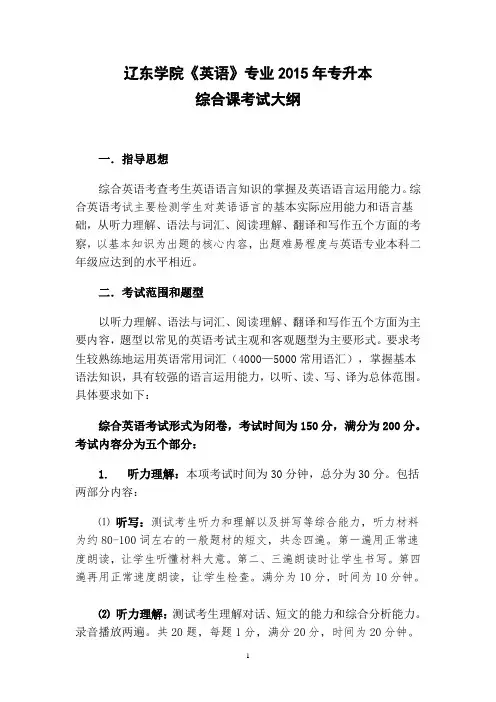
辽东学院《英语》专业2015年专升本综合课考试大纲一.指导思想综合英语考查考生英语语言知识的掌握及英语语言运用能力。
综合英语考试主要检测学生对英语语言的基本实际应用能力和语言基础,从听力理解、语法与词汇、阅读理解、翻译和写作五个方面的考察,以基本知识为出题的核心内容,出题难易程度与英语专业本科二年级应达到的水平相近。
二.考试范围和题型以听力理解、语法与词汇、阅读理解、翻译和写作五个方面为主要内容,题型以常见的英语考试主观和客观题型为主要形式。
要求考生较熟练地运用英语常用词汇(4000—5000常用语汇),掌握基本语法知识,具有较强的语言运用能力,以听、读、写、译为总体范围。
具体要求如下:综合英语考试形式为闭卷,考试时间为150分,满分为200分。
考试内容分为五个部分:1.听力理解:本项考试时间为30分钟,总分为30分。
包括两部分内容:⑴听写:测试考生听力和理解以及拼写等综合能力,听力材料为约80-100词左右的一般题材的短文,共念四遍。
第一遍用正常速度朗读,让学生听懂材料大意。
第二、三遍朗读时让学生书写。
第四遍再用正常速度朗读,让学生检查。
满分为10分,时间为10分钟。
⑵听力理解:测试考生理解对话、短文的能力和综合分析能力。
录音播放两遍。
共20题,每题1分,满分20分,时间为20分钟。
2.词汇与语法:主要考查学生对常用词汇(4000—5000词汇左右)熟练使用及应用能力,着重考察考生掌握基本的语法知识、基本词汇的应用能力和常用的句型情况,以多项选择或完形填空的形式为主要题型。
共设40道多项选择题,每题1分,满分为40分,时间为20分钟。
3.阅读理解:考查获取书面信息能力的速度和准确性,题材包括社会、文化、经济、科普等方面的说明文、记叙文、议论文。
要求考生阅读5篇总词数为2000单词的英语短文,根据内容得出每个问题的最佳答案,共设25个问题,每题2分,满分为50分,时间为40分钟。
4.翻译:其中英译汉、汉译英各50%。
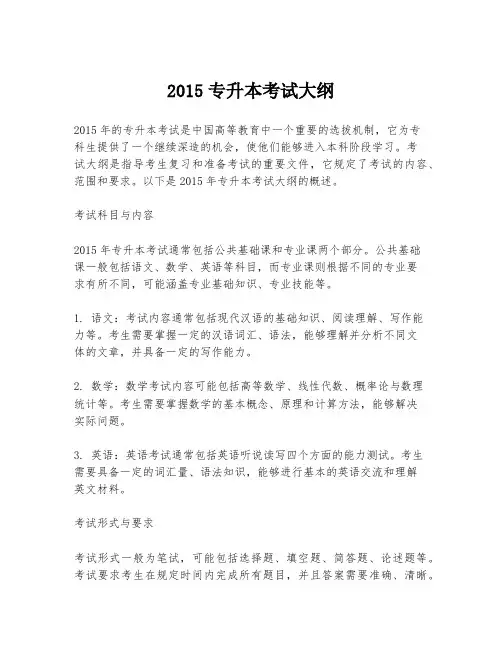
2015专升本考试大纲2015年的专升本考试是中国高等教育中一个重要的选拔机制,它为专科生提供了一个继续深造的机会,使他们能够进入本科阶段学习。
考试大纲是指导考生复习和准备考试的重要文件,它规定了考试的内容、范围和要求。
以下是2015年专升本考试大纲的概述。
考试科目与内容2015年专升本考试通常包括公共基础课和专业课两个部分。
公共基础课一般包括语文、数学、英语等科目,而专业课则根据不同的专业要求有所不同,可能涵盖专业基础知识、专业技能等。
1. 语文:考试内容通常包括现代汉语的基础知识、阅读理解、写作能力等。
考生需要掌握一定的汉语词汇、语法,能够理解并分析不同文体的文章,并具备一定的写作能力。
2. 数学:数学考试内容可能包括高等数学、线性代数、概率论与数理统计等。
考生需要掌握数学的基本概念、原理和计算方法,能够解决实际问题。
3. 英语:英语考试通常包括英语听说读写四个方面的能力测试。
考生需要具备一定的词汇量、语法知识,能够进行基本的英语交流和理解英文材料。
考试形式与要求考试形式一般为笔试,可能包括选择题、填空题、简答题、论述题等。
考试要求考生在规定时间内完成所有题目,并且答案需要准确、清晰。
1. 选择题:考生需要从四个选项中选择最合适的答案。
这类题目考察考生对知识点的掌握程度和理解能力。
2. 填空题:考生需要根据题目要求填写正确的答案。
这类题目考察考生的记忆力和对知识点的熟练程度。
3. 简答题:考生需要对问题进行简要回答。
这类题目考察考生的分析和表达能力。
4. 论述题:考生需要对问题进行详细的论述。
这类题目考察考生的综合分析能力和表达能力。
复习建议1. 系统复习:考生应该系统地复习所有考试科目的知识点,确保没有遗漏。
2. 模拟练习:通过模拟考试来检验复习效果,熟悉考试流程和时间管理。
3. 重点突破:针对自己的薄弱环节进行重点复习和练习,提高解题能力。
4. 心理调适:保持良好的心态,避免过度紧张,确保在考试中能够发挥出最佳水平。
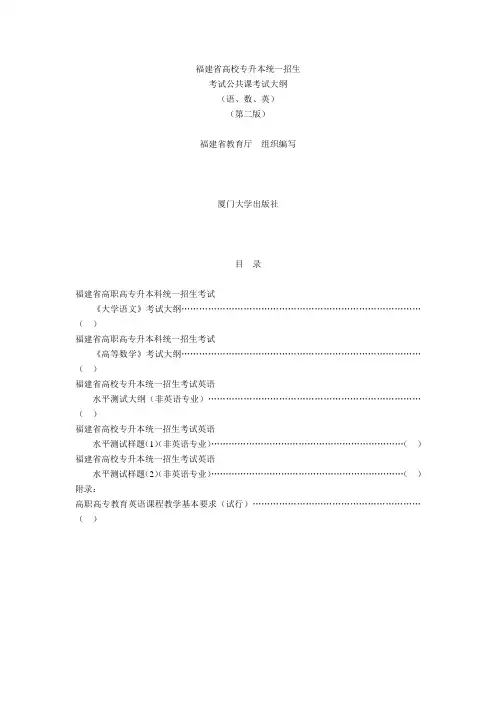
福建省高校专升本统一招生考试公共课考试大纲(语、数、英)(第二版)福建省教育厅组织编写厦门大学出版社目录福建省高职高专升本科统一招生考试《大学语文》考试大纲………………………………………………………………………()福建省高职高专升本科统一招生考试《高等数学》考试大纲………………………………………………………………………()福建省高校专升本统一招生考试英语水平测试大纲(非英语专业)………………………………………………………………()福建省高校专升本统一招生考试英语水平测试样题(1)(非英语专业)…………………………………………………………()福建省高校专升本统一招生考试英语水平测试样题(2)(非英语专业)…………………………………………………………()附录:高职高专教育英语课程教学基本要求(试行)…………………………………………………()福建省高校专升本统一招生考试英语水平测试大纲(非英语专业)一、总则国家教育部高教司在“关于印发《高职高专教育英语课程教学基本要求》(试行)的通知”[(2000)57号文件]中指出,高职高专教育以培养学生实际运用语言能力为目标,突出教学内容的实用性和针对性;针对目前高职高专学生入学水平参差不齐的情况,实行统一要求、分级指导的原则。
《高职高专教育英语课程教学基本要求》(以下简称《基本要求》)对英语教学提出了应达到的合格要求,把教学和测试分为A、B两级。
B级是过渡要求,A级是标准要求。
福建省高职高专升本科英语水平测试根据《基本要求》的精神,参照福建省教育厅组织编写的《英语基础教程》(高职高专版)系列教材的教学内容,全面考核《基本要求》中所提出的各项目标。
《基本要求》中指出:高职高专教育英语课程的教学目的是,经过180-220学时的教学,使学生掌握一定的英语基础知识技能,具有一定的听、说、读、写、译的能力,从而借助词典阅读和翻译有关英语业务资料,在涉外交际的日常活动中进行简单的口头和书面交流,并为今后进一步提高英语的交际能力打下基础。
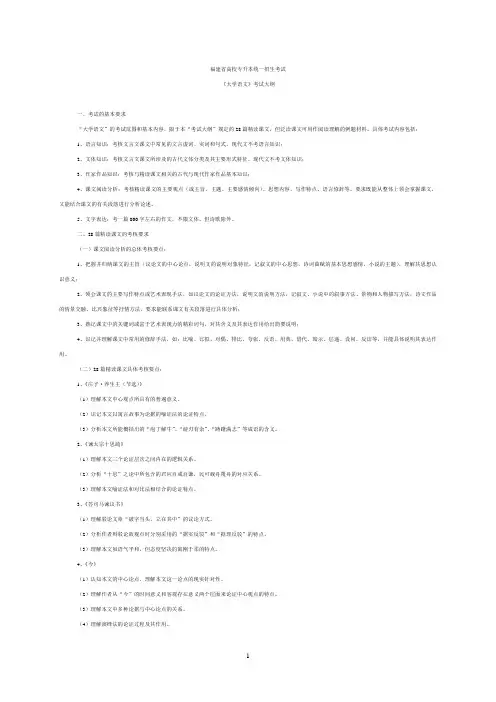
福建省高校专升本统一招生考试《大学语文》考试大纲一、考试的基本要求“大学语文”的考试范围和基本内容,限于本“考试大纲”规定的28篇精读课文,但泛读课文可用作阅读理解的例题材料。
具体考试内容包括:1、语言知识:考核文言文课文中常见的文言虚词、实词和句式。
现代文不考语言知识;2、文体知识:考核文言文课文所涉及的古代文体分类及其主要形式特征。
现代文不考文体知识;3、作家作品知识:考核与精读课文相关的古代与现代作家作品基本知识;4、课文阅读分析:考核精读课文的主要观点(或主旨、主题、主要感情倾向)、思想内容、写作特点、语言修辞等。
要求既能从整体上领会掌握课文,又能结合课文的有关段落进行分析论述。
5、文字表达:考一篇800字左右的作文,不限文体,但诗歌除外。
二、28篇精读课文的考核要求(一)课文阅读分析的总体考核要点:1、把握并归纳课文的主旨(议论文的中心论点,说明文的说明对象特征,记叙文的中心思想,诗词曲赋的基本思想感情,小说的主题),理解其思想认识意义;2、领会课文的主要写作特点或艺术表现手法,如议论文的论证方法,说明文的说明方法,记叙文、小说中的叙事方法、景物和人物描写方法,诗文作品的情景交融、比兴象征等抒情方法,要求能联系课文有关段落进行具体分析;3、熟记课文中的关键词或富于艺术表现力的精彩词句,对其含义及其表达作用给出简要说明;4、识记并理解课文中常用的修辞手法,如:比喻、比拟、对偶、排比、夸张、反语、用典、借代、暗示、层递、设问、反诘等,并能具体说明其表达作用。
(二)28篇精读课文具体考核要点:1、《庄子·养生主(节选)》(1)理解本文中心观点所具有的普遍意义。
(2)识记本文以寓言故事为论据的喻证法的论证特点。
(3)分析本文所能概括出的“庖丁解牛”、“游刃有余”、“踌躇满志”等成语的含义。
2、《谏太宗十思疏》(1)理解本文三个论证层次之间内在的逻辑关系。
(2)分析“十思”之论中所包含的君应自戒自谦,民可载舟覆舟的对应关系。
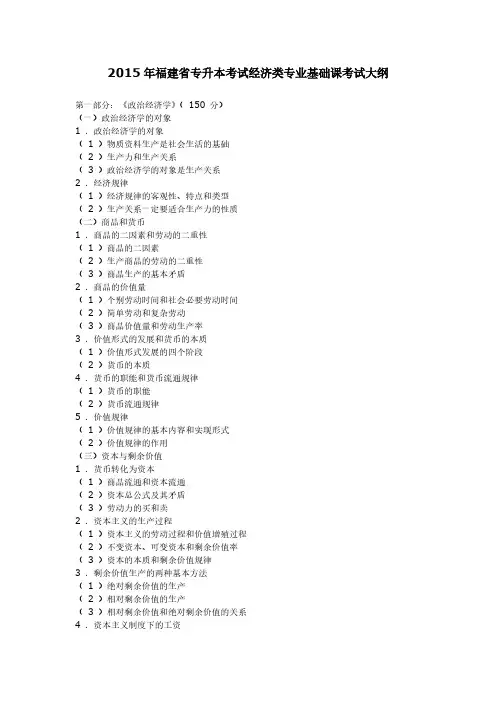
2015年福建省专升本考试经济类专业基础课考试大纲第一部分:《政治经济学》(150 分)(一)政治经济学的对象1 .政治经济学的对象( 1 )物质资料生产是社会生活的基础( 2 )生产力和生产关系( 3 )政治经济学的对象是生产关系2 .经济规律( 1 )经济规律的客观性、特点和类型( 2 )生产关系一定要适合生产力的性质(二)商品和货币1 .商品的二因素和劳动的二重性( 1 )商品的二因素( 2 )生产商品的劳动的二重性( 3 )商品生产的基本矛盾2 .商品的价值量( 1 )个别劳动时间和社会必要劳动时间( 2 )简单劳动和复杂劳动( 3 )商品价值量和劳动生产率3 .价值形式的发展和货币的本质( 1 )价值形式发展的四个阶段( 2 )货币的本质4 .货币的职能和货币流通规律( 1 )货币的职能( 2 )货币流通规律5 .价值规律( 1 )价值规律的基本内容和实现形式( 2 )价值规律的作用(三)资本与剩余价值1 .货币转化为资本( 1 )商品流通和资本流通( 2 )资本总公式及其矛盾( 3 )劳动力的买和卖2 .资本主义的生产过程( 1 )资本主义的劳动过程和价值增殖过程( 2 )不变资本、可变资本和剩余价值率( 3 )资本的本质和剩余价值规律3 .剩余价值生产的两种基本方法( 1 )绝对剩余价值的生产( 2 )相对剩余价值的生产( 3 )相对剩余价值和绝对剩余价值的关系4 .资本主义制度下的工资( 1 )资本主义工资的本质( 2 )工资的形式(四)资本积累1 .简单再生产和扩大再生产( 1 )生产和再生产( 2 )资本主义的简单再生产( 3 )资本主义的扩大再生产( 4 )影响资本积累量的几个因素2 .资本有机构成提高和相对人口过剩( 1 )资本有机构成及其提高( 2 )资本的积聚和集中( 3 )相对人口过剩(五)资本的循环与周转1 .资本循环( 1 )产业资本循环的三个阶段和三种形式( 2 )产业资本循环是三种循环的统一2 .资本周转( 1 )资本的周转时间和周转速度( 2 )固定资本和流动资本( 3 )预付资本的总周转( 4 )资本周转速度对剩余价值生产的影响(六)社会总资本的再生产和经济危机1 .社会总资本和社会总产品( 1 )个别资本的再生产和社会总资本的再生产( 2 )社会总资本再生产的核心问题是社会总产品的实现问题2 .社会总资本的简单再生产( 1 )社会总产品实现过程的三大交换( 2 )简单再生产的实现条件3 .社会总资本的扩大再生产( 1 )扩大再生产的前提条件( 2 )扩大再生产的实现过程( 3 )扩大再生产的实现条件( 4 )生产资料生产的优先增长4 .资本主义的经济危机( 1 )经济危机的现象和实质( 2 )经济危机的根源和直接原因( 3 )经济危机的周期性及其物质基础( 4 )战后经济危机的特点(七)剩余价值的分配• 利润和平均利润( 1 )利润与利润率( 2 )利润平均化与生产价格2 .商业资本和商业利润( 1 )商业资本的形成( 2 )商业资本的职能作用( 3 )商业利润3 .借贷资本和银行利润( 1 )借贷资本的形成、本质和特点( 2 )借贷利息和企业利润( 3 )利息率( 4 )银行资本和银行利润4 .资本主义土地所有制和地租( 1 )资本主义土地所有制和地租( 2 )级差地租( 3 )绝对地租( 4 )地租、地价对经济发展的影响(八)私人垄断资本主义1 .垄断的形成( 1 )从自由竞争到垄断的转变( 2 )垄断组织的形式和实质( 3 )垄断利润和垄断价格( 4 )垄断和竞争的关系2 .金融资本和金融寡头( 1 )银行业的垄断和银行的新作用( 2 )金融资本的形成( 3 )金融寡头的统治3 .战后私人垄断资本主义的发展变化( 1 )垄断程度不断提高( 2 )垄断组织经营方式日趋多样化,“混合联合公司”广泛发展( 3 )金融垄断集团统治的新变化、新特点4 .资本主义经济危机( 1 )经济危机的实质( 2 )经济危机的形成机制(九)国家垄断资本主义1 .国家垄断资本主义的产生和发展( 1 )国家垄断资本主义产生和发展的过程( 2 )战后国家垄断资本主义持续迅速发展的原因• 国家垄断资本主义的基本形式( 1 )国有垄断资本( 2 )国家和私人共有的垄断资本( 3 )国家和私人密切联系的垄断资本• 国家垄断资本主义对社会经济生活的干预和调节( 1 )国家垄断资本主义干预和调节社会经济生活的必要性( 2 )国家垄断资本主义干预和调节社会经济生活的主要政策措施4 .国家垄断资本主义的实质和作用( 1 )国家垄断资本主义的实质( 2 )国家垄断资本主义的两重作用(十)国际垄断和经济全球化1 .国际垄断组织( 1 )国际垄断组织的主要形式( 2 )国际垄断组织的本质2 .跨国公司( 1 )跨国公司的形成和发展( 2 )跨国公司的主要特征( 3 )当代跨国公司对外直接投资的新特点• 经济全球化( 1 )经济全球化的形成和发展( 2 )经济全球化的主要内容( 3 )经济全球化对各国经济的影响考试题型:• 单选约30%• 判断约20%• 简答约27%• 计算约13%• 论述约10%主要参考教材《政治经济学》刘熙钧主编厦门大学出版社2003 年9 月第 3 版第二部分:《西方经济学》(150 分)(一)导言1 、经济学的研究对象( 1 )资源的稀缺性。
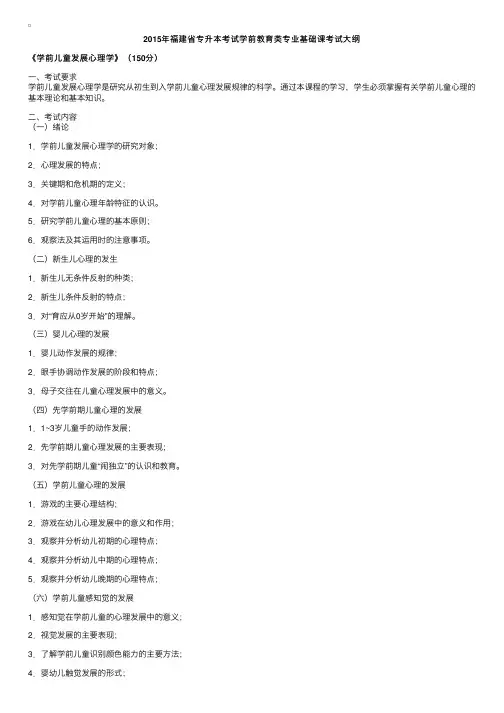
2015年福建省专升本考试学前教育类专业基础课考试⼤纲《学前⼉童发展⼼理学》(150分)⼀、考试要求学前⼉童发展⼼理学是研究从初⽣到⼊学前⼉童⼼理发展规律的科学。
通过本课程的学习,学⽣必须掌握有关学前⼉童⼼理的基本理论和基本知识。
⼆、考试内容(⼀)绪论1.学前⼉童发展⼼理学的研究对象;2.⼼理发展的特点;3.关键期和危机期的定义;4.对学前⼉童⼼理年龄特征的认识。
5.研究学前⼉童⼼理的基本原则;6.观察法及其运⽤时的注意事项。
(⼆)新⽣⼉⼼理的发⽣1.新⽣⼉⽆条件反射的种类;2.新⽣⼉条件反射的特点;3.对“育应从0岁开始”的理解。
(三)婴⼉⼼理的发展1.婴⼉动作发展的规律;2.眼⼿协调动作发展的阶段和特点;3.母⼦交往在⼉童⼼理发展中的意义。
(四)先学前期⼉童⼼理的发展1.1~3岁⼉童⼿的动作发展;2.先学前期⼉童⼼理发展的主要表现;3.对先学前期⼉童“闹独⽴”的认识和教育。
(五)学前⼉童⼼理的发展1.游戏的主要⼼理结构;2.游戏在幼⼉⼼理发展中的意义和作⽤;3.观察并分析幼⼉初期的⼼理特点;4.观察并分析幼⼉中期的⼼理特点;5.观察并分析幼⼉晚期的⼼理特点;(六)学前⼉童感知觉的发展1.感知觉在学前⼉童的⼼理发展中的意义;2.视觉发展的主要表现;3.了解学前⼉童识别颜⾊能⼒的主要⽅法;4.婴幼⼉触觉发展的形式;5.⼿的探索活动形成和发展的阶段;6.⼉童左右⽅位知觉的发展阶段;7.“视崖”实验;8.学前⼉童形状知觉能⼒的发展趋势;9.幼⼉时间知觉的特点;10.幼⼉观察⼒发展的特点;11.影响学前⼉童感知觉发展的因素;12.促进学前⼉童感知觉发展的措施。
(七)学前⼉童注意的发展1.注意在学前⼉童⼼理发展中的意义;2.引起学前⼉童⽆意注意的原因;3.幼⼉⽆意注意的发展;4.影响幼⼉有意注意的因素;5.幼⼉有意注意的发展;6.幼⼉注意品质的发展;7.影响幼⼉注意分散的原因;8.防⽌幼⼉注意分散的措施。
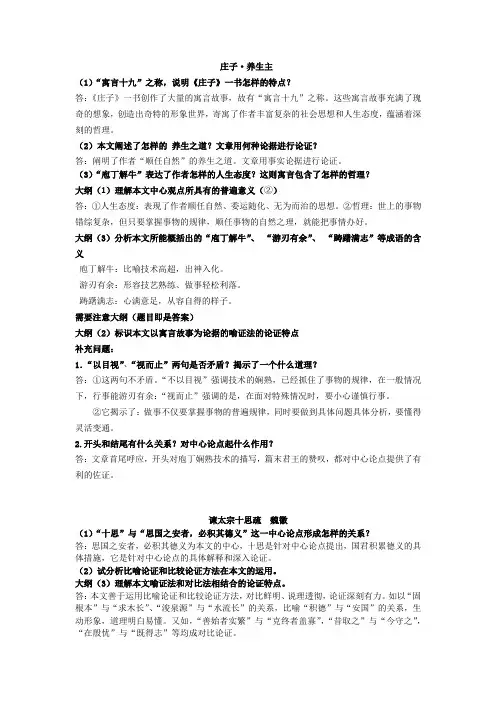
庄子·养生主(1)“寓言十九”之称,说明《庄子》一书怎样的特点?答:《庄子》一书创作了大量的寓言故事,故有“寓言十九”之称。
这些寓言故事充满了瑰奇的想象,创造出奇特的形象世界,寄寓了作者丰富复杂的社会思想和人生态度,蕴涵着深刻的哲理。
(2)本文阐述了怎样的养生之道?文章用何种论据进行论证?答:阐明了作者“顺任自然”的养生之道。
文章用事实论据进行论证。
(3)“庖丁解牛”表达了作者怎样的人生态度?这则寓言包含了怎样的哲理?大纲(1)理解本文中心观点所具有的普遍意义(②)答:①人生态度:表现了作者顺任自然、委运随化、无为而治的思想。
②哲理:世上的事物错综复杂,但只要掌握事物的规律,顺任事物的自然之理,就能把事情办好。
大纲(3)分析本文所能概括出的“庖丁解牛”、“游刃有余”、“踌躇满志”等成语的含义庖丁解牛:比喻技术高超,出神入化。
游刃有余:形容技艺熟练、做事轻松利落。
踌躇满志:心满意足,从容自得的样子。
需要注意大纲(题目即是答案)大纲(2)标识本文以寓言故事为论据的喻证法的论证特点补充问题:1.“以目视”、“视而止”两句是否矛盾?揭示了一个什么道理?答:①这两句不矛盾。
“不以目视”强调技术的娴熟,已经抓住了事物的规律,在一般情况下,行事能游刃有余:“视而止”强调的是,在面对特殊情况时,要小心谨慎行事。
②它揭示了:做事不仅要掌握事物的普遍规律,同时要做到具体问题具体分析,要懂得灵活变通。
2.开头和结尾有什么关系?对中心论点起什么作用?答:文章首尾呼应,开头对庖丁娴熟技术的描写,篇末君王的赞叹,都对中心论点提供了有利的佐证。
谏太宗十思疏魏徽(1)“十思”与“思国之安者,必积其德义”这一中心论点形成怎样的关系?答:思国之安者,必积其德义为本文的中心,十思是针对中心论点提出,国君积累德义的具体措施,它是针对中心论点的具体解释和深入论证。
(2)试分析比喻论证和比较论证方法在本文的运用。
大纲(3)理解本文喻证法和对比法相结合的论证特点。
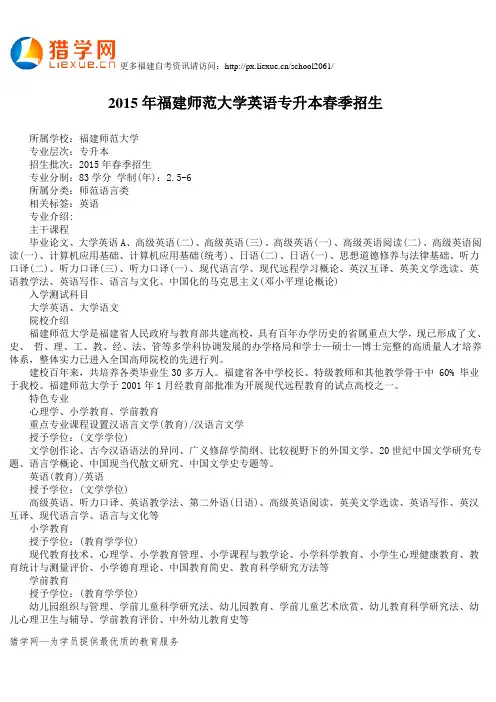
2015年福建师范大学英语专升本春季招生所属学校:福建师范大学专业层次:专升本招生批次:2015年春季招生专业分制:83学分学制(年):2.5-6所属分类:师范语言类相关标签:英语专业介绍:主干课程毕业论文、大学英语A、高级英语(二)、高级英语(三)、高级英语(一)、高级英语阅读(二)、高级英语阅读(一)、计算机应用基础、计算机应用基础(统考)、日语(二)、日语(一)、思想道德修养与法律基础、听力口译(二)、听力口译(三)、听力口译(一)、现代语言学、现代远程学习概论、英汉互译、英美文学选读、英语教学法、英语写作、语言与文化、中国化的马克思主义(邓小平理论概论)入学测试科目大学英语、大学语文院校介绍福建师范大学是福建省人民政府与教育部共建高校,具有百年办学历史的省属重点大学,现已形成了文、史、哲、理、工、教、经、法、管等多学科协调发展的办学格局和学士—硕士—博士完整的高质量人才培养体系,整体实力已进入全国高师院校的先进行列。
建校百年来,共培养各类毕业生30多万人。
福建省各中学校长、特级教师和其他教学骨干中 60% 毕业于我校。
福建师范大学于2001年1月经教育部批准为开展现代远程教育的试点高校之一。
特色专业心理学、小学教育、学前教育重点专业课程设置汉语言文学(教育)/汉语言文学授予学位:(文学学位)文学创作论、古今汉语语法的异同、广义修辞学简纲、比较视野下的外国文学、20世纪中国文学研究专题、语言学概论、中国现当代散文研究、中国文学史专题等。
英语(教育)/英语授予学位:(文学学位)高级英语、听力口译、英语教学法、第二外语(日语)、高级英语阅读、英美文学选读、英语写作、英汉互译、现代语言学、语言与文化等小学教育授予学位:(教育学学位)现代教育技术、心理学、小学教育管理、小学课程与教学论、小学科学教育、小学生心理健康教育、教育统计与测量评价、小学德育理论、中国教育简史、教育科学研究方法等学前教育授予学位:(教育学学位)幼儿园组织与管理、学前儿童科学研究法、幼儿园教育、学前儿童艺术欣赏、幼儿教育科学研究法、幼儿心理卫生与辅导、学前教育评价、中外幼儿教育史等思想政治教育授予学位:(法学学位)政治经济学原理原著、邓小平理论概论、中华人民共和国史、西方经济学、行政管理学、人生哲学与传统道德、当代资本主义、哲学原理原著、心理学等公共事业管理(教育管理)授予学位:(管理学学位)教育原理、现代教育技术、教育管理原理、德育论、教育科学研究方法、管理心理学、学校心理健康教育、课程与教学论、比较教育学、中国教育简史等数学与应用数学(教育)/数学与应用数学授予学位:(理学学位)数学分析选讲、高等代数选讲、初等数论、复变函数、常微分方程、近世代数、实变函数、概率论、数学教育学、数学建模、教育学等化学(教育)/化学授予学位:(理学学位)教育学、生物化学、物理化学、中级无机化学专题、仪器分析、中学化学实验研讨、中级有机化学、环境学、心理学、结构化学、物理化学实验等历史学(教育)/历史学授予学位:(历史学学位)中国古代史专题、中学历史教材教法、中国近代史专题、世界现当代史专题、中国现代史专题、中国历史地理、教育学、中国政治制度史等体育教育/体育学类(体育)授予学位:(教育学学位)体育保健学、体育测量与评价、学校健康教育学、运动训练学、体育管理学、体育教育学、专项提高课、体育科学研究方法、体育史等物理学(教育)/物理学授予学位:(理学学位)数学物理方法、数据库管理与应用、量子力学、实验物理导论、电动力学、热力学与统计物理、中学物理教法研究、计算机网络与通讯、教育学等生物科学(教育)/生物科学授予学位:(理学学位)发育生物学、生物统计学、细胞生物学、分子生物学、生态学、进化生物学、环境生物学、人口与青春健康教育、中学生物教学与实践、生物多媒体课件制作、生物教学论等地理科学(教育)/地理科学授予学位:(理学学位)城镇体系规划、海洋地理学、灾害地理学、人文地理学、旅游地理学、综合自然地理、地理教学法、经济地理学、环境保护、遥感导论等心理学授予学位:(理学学位)学校心理健康教育、管理心理学、人格心理学、发展心理学、社会心理学、普通心理学、教育心理学、教育学、心理咨询学、变态心理学、心理测量学等法学授予学位:(法学学位)法理学、宪法学、民法概要、刑法学、外国法制史、商法概论、国际私法、国际经济法、金融法、保险法、知识产权法、公司法等行政管理授予学位:(管理学学位)行政管理学、组织行为学、公共关系学、人力资源管理学、国际政治学、公共财政学、公共政策概论、市政学、社会保障政策与管理、国际政治学等计算机科学与技术授予学位:(工学学位)计算机组成原理、多媒体应用技术、计算机网络与通讯、网络管理与应用、数据库管理与应用、计算机体系结构、网页设计技术、操作系统导论、C++语言程序设计、计算机原理与接口技术等工商管理授予学位:(管理学学位)管理学概论、基础会计、市场营销学、经济法律通论、企业会计、国家税收、工商行政管理、人力资源管理、国家税收、经济法律通论、国际贸易等经济学授予学位:(经济学学位)线性代数与概率统计、市场营销学、西方经济学、外国经济学说史、国际贸易、财务管理、统计学、证券投资学、公共关系学等财务管理授予学位:(管理学学位)管理学概论、政治经济原理原著、财务会计、成本管理会计、证券投资学、财务管理、电算会计、审计学、企业会计、货币银行学、项目评估等软件工程授予学位:(工学学位)网络管理与应用、Linux操作系统管理、软件体系结构、软件工程、软件测试技术、面向web应用程序设计、IT项目管理、网络信息安全、软件过程管理等电子信息工程授予学位:(理学学位)数字信号处理、高频电子线路、信号与系统、通信原理、C++语言程序设计、TCP/IP协议原理与编程、EDA 技术、现代交换技术等物流管理授予学位:(待定)市场调查与预策决策、物流管理概论、电子商务理论与实践、供应链管理、配送与配送中心、国际贸易理论与实务、管理信息系统、物流系统分析与设计等会计授予学位:(专科不授予)数据库应用、基础会计、财务会计、成本管理会计、财务管理、经济法律通论、国家税收、高等数学、管理会计、市场营销学、电算会计等艺术设计授予学位:(文学学位)计算机辅助设计1(PS)、素描、构成设计、计算机辅助设计-3DMAX、VI设计、包装设计、招贴设计、文艺美学、商标设计、文学艺术产业等艺术设计 ( 动画方向 )授予学位::(文学学位)文学艺术产业、动画造型基础(素描)、漫画与插画、计算机辅助设计1(PS)、人物场景设定、动画运动规律及分镜头设计、计算机辅助设计-MAYA、网页设计、文艺美学等旅游管理授予学位:(管理学学位)旅游规划与开发、旅游消费者行为学、饭店经营管理、旅游管理专业英语、旅行社经营与管理、台湾历史文化、旅游经济学、旅游管理学、旅游电子商务等农村行政与经济管理(村务管理)授予学位:(专科不授予)基层行政管理学、农村人力资源管理、农村政策分析、公务员应试技巧、乡镇环境保护与资源开发、基层领导方法与艺术、乡村文化建设、乡镇规划原理等金融学授予学位:(经济学学位)代数与概率统计、西方经济学、财政学、保险学、金融学原理、国际经济学、证券投资学、商业银行经营与管理,投资银行业务与管理、金融市场学、国际结算等★各专业课程设置,随着学科建设和课程发展会有所调整,以学生就读时的教学计划为准。
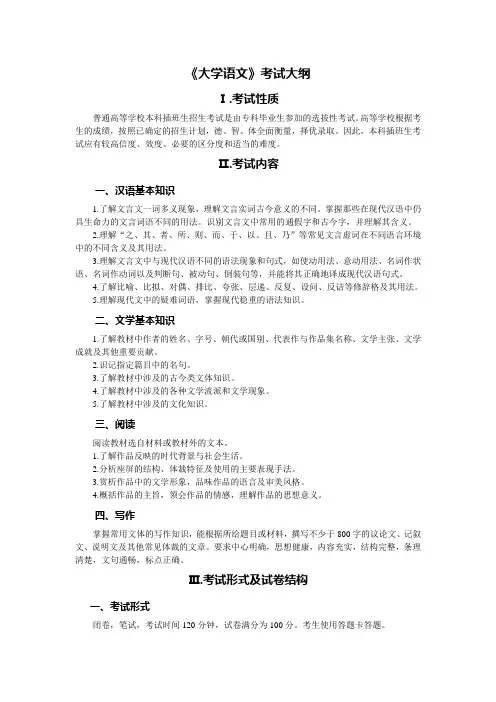
《大学语文》考试大纲Ⅰ.考试性质普通高等学校本科插班生招生考试是由专科毕业生参加的选拔性考试。
高等学校根据考生的成绩,按照已确定的招生计划,德、智、体全面衡量,择优录取。
因此,本科插班生考试应有较高信度、效度、必要的区分度和适当的难度。
Ⅱ.考试内容一、汉语基本知识1.了解文言文一词多义现象,理解文言实词古今意义的不同。
掌握那些在现代汉语中仍具生命力的文言词语不同的用法。
识别文言文中常用的通假字和古今字,并理解其含义。
2.理解“之、其、者、所、则、而、于、以、且、乃”等常见文言虚词在不同语言环境中的不同含义及其用法。
3.理解文言文中与现代汉语不同的语法现象和句式,如使动用法、意动用法、名词作状语、名词作动词以及判断句、被动句、倒装句等,并能将其正确地译成现代汉语句式。
4.了解比喻、比拟、对偶、排比、夸张、层递、反复、设问、反诘等修辞格及其用法。
5.理解现代文中的疑难词语,掌握现代稳重的语法知识。
二、文学基本知识1.了解教材中作者的姓名、字号、朝代或国别、代表作与作品集名称、文学主张、文学成就及其他重要贡献。
2.识记指定篇目中的名句。
3.了解教材中涉及的古今类文体知识。
4.了解教材中涉及的各种文学流派和文学现象。
5.了解教材中涉及的文化知识。
三、阅读阅读教材选自材料或教材外的文本。
1.了解作品反映的时代背景与社会生活。
2.分析座屏的结构、体裁特征及使用的主要表现手法。
3.赏析作品中的文学形象,品味作品的语言及审美风格。
4.概括作品的主旨,领会作品的情感,理解作品的思想意义。
四、写作掌握常用文体的写作知识,能根据所给题目或材料,撰写不少于800字的议论文、记叙文、说明文及其他常见体裁的文章。
要求中心明确,思想健康,内容充实,结构完整,条理清楚,文句通畅,标点正确。
Ⅲ.考试形式及试卷结构一、考试形式闭卷,笔试,考试时间120分钟,试卷满分为100分。
考生使用答题卡答题。
二、知识内容比例1.汉语基本知识约20%2.文学基本知识约20%3.阅读约20%4.写作40%三、试题题型及赋分1.选择题约15%2.古文翻译题约15%3.填空题约5%4.阅读题约25%5.作文40%四、试题难易比例容易题约30%中等难度题约45%难题约25%Ⅳ.参考书目及指定篇目一、参考书目徐中玉、齐森华主编:《大学语文》(第十版),上海:华东师范大学出版社。
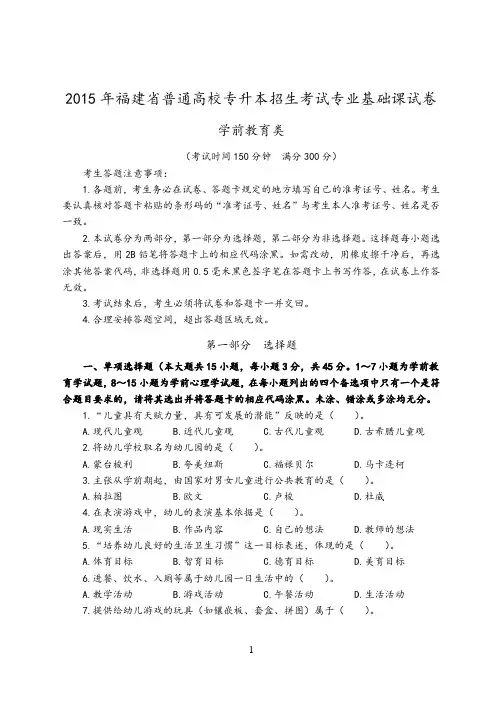
2015年福建省普通高校专升本招生考试专业基础课试卷学前教育类(考试时间150分钟满分300分)考生答题注意事项:1.各题前,考生务必在试卷、答题卡规定的地方填写自己的准考证号、姓名。
考生要认真核对答题卡粘贴的条形码的“准考证号、姓名”与考生本人准考证号、姓名是否一致。
2.本试卷分为两部分,第一部分为选择题,第二部分为非选择题。
这择题每小题选出答案后,用2B铅笔将答题卡上的相应代码涂黑。
如需改动,用橡皮擦干净后,再选涂其他答案代码,非选择题用0.5毫米黑色签字笔在答题卡上书写作答,在试卷上作答无效。
3.考试结束后,考生必须将试卷和答题卡一并交回。
4.合理安排答题空间,超出答题区域无效。
第一部分选择题一、单项选择题(本大题共15小题,每小题3分,共45分。
1~7小题为学前教育学试题,8~15小题为学前心理学试题,在每小题列出的四个备选项中只有一个是符合题目要求的,请将其选出并将答题卡的相应代码涂黑。
未涂、错涂或多涂均无分。
1.“儿童具有天赋力量,具有可发展的潜能”反映的是()。
A.现代儿童观B.近代儿童观C.古代儿童观D.古希腊儿童观2.将幼儿学校取名为幼儿园的是()。
A.蒙台梭利B.夸美纽斯C.福禄贝尔D.马卡连柯3.主张从学前期起,由国家对男女儿童进行公共教育的是()。
A.柏拉图B.欧文C.卢梭D.杜威4.在表演游戏中,幼儿的表演基本依据是()。
A.现实生活B.作品内容C.自己的想法D.教师的想法5.“培养幼儿良好的生活卫生习惯”这一目标表述,体现的是()。
A.体育目标B.智育目标C.德育目标D.美育目标6.进餐、饮水、入厕等属于幼儿园一日生活中的()。
A.教学活动B.游戏活动C.午餐活动D.生活活动7.提供给幼儿游戏的玩具(如镶嵌板、套盒、拼图)属于()。
A.结构游戏玩具B.体育游戏玩具C.智力游戏玩具D.娱乐玩具8.当刺激物触及新生儿的眼睑或睫毛时,新生儿的头会向后仰并眨眼。
这是()。
A.无条件防御反射B.无条件定向反射C.惊跳反射D.巴宾斯基反射9.幼儿认为“早上是上幼儿园的时间”“晚上是看完动画片上床睡觉的时间”,这表明幼儿的时间知觉是依靠()。
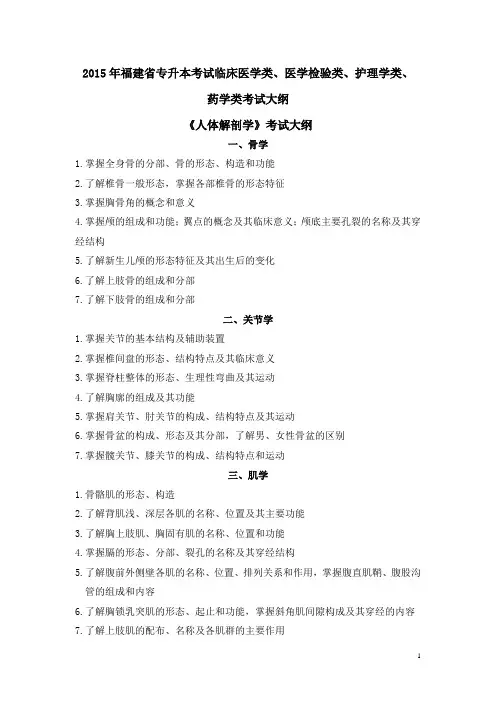
2015年福建省专升本考试临床医学类、医学检验类、护理学类、药学类考试大纲《人体解剖学》考试大纲一、骨学1.掌握全身骨的分部、骨的形态、构造和功能2.了解椎骨一般形态,掌握各部椎骨的形态特征3.掌握胸骨角的概念和意义4.掌握颅的组成和功能;翼点的概念及其临床意义;颅底主要孔裂的名称及其穿经结构5.了解新生儿颅的形态特征及其出生后的变化6.了解上肢骨的组成和分部7.了解下肢骨的组成和分部二、关节学1.掌握关节的基本结构及辅助装置2.掌握椎间盘的形态、结构特点及其临床意义3.掌握脊柱整体的形态、生理性弯曲及其运动4.了解胸廓的组成及其功能5.掌握肩关节、肘关节的构成、结构特点及其运动6.掌握骨盆的构成、形态及其分部,了解男、女性骨盆的区别7.掌握髋关节、膝关节的构成、结构特点和运动三、肌学1.骨骼肌的形态、构造2.了解背肌浅、深层各肌的名称、位置及其主要功能3.了解胸上肢肌、胸固有肌的名称、位置和功能4.掌握膈的形态、分部、裂孔的名称及其穿经结构5.了解腹前外侧壁各肌的名称、位置、排列关系和作用,掌握腹直肌鞘、腹股沟管的组成和内容6.了解胸锁乳突肌的形态、起止和功能,掌握斜角肌间隙构成及其穿经的内容7.了解上肢肌的配布、名称及各肌群的主要作用8.了解下肢肌的配布、名称及各肌群的主要作用四、神经系统1.了解神经系统的组成、神经元的分类,掌握神经系统的主要常用术语(一)中枢神经系统1.掌握脊髓的位置、形态和脊髓节段的概念;了解脊髓内部结构概况2.掌握脑干的分部,了解外形和脑干的内部结构概况3.掌握小脑的位置、分叶和功能4.了解间脑的分部、各部的外形及间脑的内部结构概况5.了解大脑半球的分叶、重要沟回及其功能;掌握脑基底核的组成及其功能,掌握内囊的位置和分部;掌握大脑皮质的主要功能区6.了解中枢神经系统感觉传导路和锥体系7.掌握脑和脊髓的被膜及硬膜外隙、蛛网膜下隙、硬脑膜窦和珠网膜粒的概念8.掌握脑室系统的组成、位置,脑脊液的产生及其循环途径9.了解脑动脉的来源和它们主要的分支和分布;掌握大脑动脉环的构成及其功能意义(二)周围神经系统1.了解周围神经系的组成2.掌握脊神经各丛的组成、位置及主要分支的名称和分布概况3.了解胸神经的分布特点4.掌握脑神经的名称、连脑位置和进出颅的位置,脑神经的主要分支名称及分布概况5.掌握内脏运动神经的组成及其低级中枢的位置;了解交感神经和副交感神经的区别五、感觉器官1.掌握角膜、巩膜、睫状体及视网膜视部的形态结构与功能2.掌握眼球折光装置的组成及其功能3.掌握房水的产生及其循环途径4.了解泪器的组成及泪液的排出途径5.掌握运动眼球的肌肉的名称和作用6.了解鼓室六壁的构成及其临床意义7.掌握咽鼓管的形态及婴幼儿咽鼓管的特点8.了解内耳的组成,掌握骨、膜迷路的构成六、脉管系统1.了解脉管系的组成、心血管系的组成和功能2.掌握体循环和肺循环的组成和功能3.掌握心的位置、外形、心各腔的形态结构;掌握心传导系统的组成和功能;掌握心的血供;了解心包、心包腔的构成及其临床意义4.掌握动脉导管的概念及其演变5.了解主动脉的起止、行程和分部;6.掌握主动脉弓的三大分支名称及其分布,颈外动脉的主要分支的名称,锁骨下动脉的主要分支的名称,上肢动脉主干的名称,掌浅弓和掌深弓的组成和位置,腹主动脉的分支名称(腹腔干、肠系膜上和下动脉)、分支及分布,子宫动脉的行程,下肢动脉主干的名称7.了解上腔静脉系的组成、属支及收集范围8.掌握头静脉、贵要静脉、肘正中静脉的起始、行径、注入部位及临床意义9.了解下腔静脉的组成、属支及收集范围10.掌握大隐静脉、小隐静脉的起始、行径、注入部位及其临床意义11.掌握肝门静脉的组成、属支及其特点,肝门静脉与上、下腔静脉的主要侧支循环途径及其临床意义12.了解淋巴系的构成及配布特点13.掌握胸导管的行径及收纳范围14.了解右淋巴导管的组成和收纳范围15.了解头颈部主要淋巴结群的分布部位、收纳范围,腋淋巴结分群、收纳范围及其临床意义,腹股沟淋巴结的分布及收纳范围七、呼吸系统1.了解鼻腔的分部及各部的形态2.掌握鼻旁窦的名称、位置和开口部位3.掌握喉的构成、喉腔的分部4.掌握左、右支气管的形态特征及其临床意义5.掌握肺的形态、构造和分叶6.掌握胸膜和胸膜腔的概念、壁胸膜的分部、胸膜隐窝及其临床意义7.了解肺和胸膜下界的体表投影8.了解纵膈的概念及其分区八、消化系统1.了解舌的形态和构造,掌握舌乳头的形态分类及其功能2.了解乳牙和恒牙的名称、牙式和出牙时间,掌握牙的形态和构造3.掌握三大唾液腺的名称、位置和腺导管的开口部位4.掌握咽的位置、分部及各部的形态特点5.掌握食管的形态、分部、食管的狭窄部位及其临床意义6.掌握胃的形态、位置和分部7.掌握十二指肠的形态、分部及各部的主要构造8.了解空、回肠的结构特点9.掌握大肠的分部及其形态特点10.掌握阑尾的形态、位置及阑尾根部的体表投影11.了解结肠的分部及各部的位置12.了解直肠的位置、形态和构造13.了解肝的形态、位置及其功能14.掌握肝外胆道的组成,胆汁的产生及其排出途径15.了解胰的形态和位置九、泌尿系统1.了解泌尿系统的组成2.掌握肾形态、位置和构造,肾的被膜及肾的固定装置3.掌握输尿管的分部、狭窄部位及其临床意义4.了解膀胱的形态、位置和分部;掌握膀胱三角的构成及其临床意义十、生殖系统1.了解男、女性生殖系统组成2.掌握睾丸的形态、位置及其功能3.掌握输精管的行程和分部,精索的构成4.掌握男性尿道的分部、三个狭窄和两个弯曲及其临床意义5.掌握精子的产生及其排出途径6.掌握卵巢的形态、位置及其功能7.掌握输卵管的分部及其意义8.掌握子宫的形态、位置和固定装置十一、腹膜1.了解腹膜、腹膜壁层和脏层配布,掌握腹膜腔的概念2.了解小网膜的位置和分部,大网膜和网膜囊的位置3.掌握各系膜的名称、位置4.掌握直肠膀胱陷凹或直肠子宫陷凹的位置及临床意义十二、内分泌系统1.了解内分泌系统的概念及其功能2.掌握甲状腺、甲状旁腺、垂体、肾上腺、胸腺、松果体的形态及位置及其功能《生理学》考试大纲一、绪论1.兴奋性(1)兴奋性的概念;(2)阈值的概念2.人体与环境(1)外环境的概念;(2)内环境的概念;(3)稳态的概念3.人体功能的调节(1)人体功能的调节方式;(2)反射的概念及结构基础;(3)反馈的概念二、细胞的基本功能1.细胞的跨膜物质转运和信号转导功能(1)单纯扩散;(2)易化扩散;(3)主动转运;(4)入胞和出胞;(5)细胞膜进行跨膜信号转导的方式2.细胞的生物电现象(1)静息电位的概念及产生的机制;(2)动作电位的概念及产生的机制;(3)动作电位的传导与局部电流3.肌细胞的收缩功能(1)神经肌肉接头处兴奋的传递过程和特点;(2)骨骼肌细胞的兴奋-收缩耦联;(3)骨骼肌的收缩形式;(4)影响骨骼肌收缩的主要因素三、血液1.血液的组成和理化特性(1)血液的组成;(2)血液的理化特性;2.血细胞(1)红细胞的生理特性;(2)白细胞的功能;(3)血小板的生理特性和功能3.血液凝固与纤维蛋白溶解(1)血液凝固的概念和过程4.血量和血型(1)血型的概念;(2)ABO血型系统;(3)输血原则四、循环1.心脏生理(1)心室肌细胞的跨膜电位及形成机制;(2)心肌的生理特性(3)心动周期的概念(4)心室收缩与射血过程;(5)心室舒张与充盈过程;(6)评价心功能的指标;(7)影响心泵血功能的因素;2.血管生理(1)血压的概念;(2)动脉血压的正常值及形成;(3)影响动脉血压的因素;(4)中心静脉压和外周静脉压的概念;(5)微循环的概念;(6)组织液生成与回流的机制;(7)影响组织液生成和回流的因素3.心血管活动的调节(1)心脏和血管的神经支配;(2)心血管反射:降压反射的概念,颈动脉窦和主动脉弓压力感受器反射;(3)体液调节:肾上腺素和去甲肾上腺素、肾素-血管紧张素系统、血管升压素4.器官循环(1)冠脉循环的血流特点;(2)冠脉循环血流量的调节五、呼吸1.肺通气(1)肺通气的动力和阻力;(2)肺通气功能的评价2.呼吸气体的交换(1)气体交换的原理;(2)气体交换的过程;(3)影响肺换气的因素3.气体在血液中的运输(1)氧和二氧化碳的结合运输;(2)血氧饱和度的概念;(3)氧解离曲线的概念及影响因素4.呼吸运动的调节(1)肺牵张反射;(2)呼吸的化学感受器反射六、消化与吸收1.概述(1)消化和吸收的概念;(2)消化的方式;(3)消化管平滑肌的生理特性;(4)消化液的功能2.口腔内消化(1)唾液的性质、成分和作用3.胃内消化(1)胃液的性质、成分和作用;(2)胃的运动形式;(3)胃排空的概念4.小肠内消化(1)胰液的性质、成分和作用;(2)胆汁的性质、成分和作用;(3)小肠的运动形式5.大肠的功能(1)排便反射6.吸收(1)糖、蛋白质、脂肪的吸收7.消化器官活动的调节(1)交感神经和副交感神经的作用;(2)胃肠激素的概念;(3)消化期胃液分泌的调节机制七、能量代谢和体温1.能量代谢(1)能量代谢的概念;(2)食物的热价、氧热价和呼吸商的概念;(3)影响能量代谢的因素;(4)基础代谢的概念2.体温及其调节(1)体温的生理变动;(2)人体的产热器官和散热部位;(3)人体的散热方式;(4)体温调节的概念八、排泄1.肾的结构和血液循环特点(1)肾血液循环的特点;(2)肾血流量的自身调节2.肾小球的滤过作用(1)肾小球滤过作用的概念;(2)影响肾小球滤过的因素3.肾小管和集合管的重吸收及其分泌作用(1)各种物质的重吸收;(2)肾糖阈的概念;(3)影响肾小管和集合管重吸收的和K+的分泌因素;(4)H+、NH34.尿的浓缩和稀释作用(1)肾髓质渗透压梯度的形成和保持5.尿生成的调节(1)血管升压素的来源、作用机制及分泌的调节;(2)醛固酮的来源、作用机制及调节6.血浆清除率(1)血浆清除率的概念;(2)测定血浆清除率的意义7.尿液及其排放(1)排尿反射九、感觉器官1.概述(1)感觉器官的概念;(2)感受器的一般生理特性2.视觉器官(1)眼的调节;(2)眼的折光异常;(3)眼的感光功能;(4)暗适应与明适应的概念;(5)视敏度的概念;(6)视野的概念3.听觉器官(1)声波传入内耳的途径;(2)内耳的感音功能;(3)听阈和听域的概念4.前庭器官(1)前庭器官的功能5.其他感觉器官十、神经系统1.神经元及反射活动的一般规律(1)神经纤维传导冲动的特征;(2)突触的概念;(3)突触传递的过程;(4)神经递质的分类;(5)中枢兴奋传布的特征(6)中枢抑制2.神经系统的感觉功能(1)感觉投射系统;(2)痛觉的概念;(3)牵涉痛的概念3.神经系统对躯体运动的调节(1)脊髓的躯体运动反射;(2)脑干对肌紧张的调节;(3)小脑调节运动的功能;(4)基底核对躯体运动的调节;(5)大脑皮层对躯体运动的调节;锥体系及其功能4.神经系统对内脏活动的调节(1)自主神经的主要功能;(2)胆碱受体、肾上腺素受体的分布及作用;(3)下丘脑对内脏活动的调节5.脑的高级功能与电活动(1)人类条件反射的两种信号系统;(2)大脑皮层的语言中枢;(3)正常脑电图的波形;(4)睡眠的时相十一、内分泌1.激素的概况(1)激素的概念;(2)激素的分类;(3)激素作用的一般特征2.下丘脑与垂体(1)下丘脑与垂体功能联系;(2)腺垂体激素及生理作用3.甲状腺(1)甲状腺激素的生理作用;(2)甲状腺激素分泌的调节4.肾上腺(1)糖皮质激素的生理作用;(2)糖皮质激素的分泌调节;(3)应急反应的概念5.胰岛(1)胰岛素的生理作用及分泌调节;(2)胰高血糖素的生理作用及分泌调节6.甲状旁腺和甲状腺C细胞(1)甲状旁腺素的生理作用及分泌调节十二、生殖1.男性生殖(1)睾丸的功能2.女性生殖(1)卵巢的功能;(2)月经周期的概念;(3)月经周期中卵巢和子宫内膜的变化《外科学》考试大纲一、外科学基础1、无菌术(1)无菌术概念(2)无菌法与抗菌法的方法2、外科病人液体平衡(1)等渗性、低渗性和高渗性缺水的病因、诊断和治疗(2)低钾血症和高钾血症的诊断和治疗原则(3)酸碱失衡的概念和类型(4)代谢性酸中毒和呼吸性碱中毒的病因、诊断和治疗措施3、外科休克和多器官功能障碍(1)失血性休克的病因和治疗原则(2)感染性休克的定义、类型和治疗(3)中心静脉压测定的意义和方法(4)多器官功能障碍综合征(MODS)的定义,发病机制、诊断指标与监测(5)急性呼吸窘迫综合征(ARDS)病因、诊断和治疗原则4、麻醉与心肺复苏(1)麻醉的基本概念(2)椎管内麻醉(包括腰麻、硬膜外阻滞麻醉)的种类、适应症和并发症(3)常用吸入麻醉方法、药物(4)静脉麻醉的方法、药物(5)疼痛的治疗:疼痛评估、诊断和治疗方法(6)心肺复苏的概念:人工呼吸和心脏按摩的原理和方法,以及脑复苏的意义和方法5、外科营养支持的方法和适应症,肠外营养(TPN)的补充方法计算6、外科感染(1)外科感染的概念、临床表现和治疗原则。
湖南财政经济学院2015年“专升本”《大学英语》科目考试大纲一、考试的基本要求要求学生掌握基本的英语语言知识和4000左右英语词汇,能熟练运用英语基本词汇、习语、句型和语法结构,了解英语篇章的结构和语言功能,具有一定的英语听、说、读、写、译能力和一定的英语综合应用能力。
二、考试的范围和内容本科目考试对象为参加选拔考试的所有非英语专业考生。
本科目考试采用客观试题与主观试题相结合、单项技能测试与综合技能测试相结合的形式,主要考查学生词汇、听力、阅读、写作等语言技能,并适当考查学生英语知识的综合应用能力。
三、考试题型和分值结构(100分)I.词汇语法 (Vocabulary and Structure) 10×1分 =10分1.测试题型(1)本部分由词汇用法题和语法结构题组成,共10题,其中词汇用法题约占80%,语法结构题约占20%。
(2)考试题型为选择题,每题有四个选择项,学生应根据题中提供的语境,从中选出一个最佳答案。
2.测试要求掌握《新视野大学英语读写教程》1-4册的基本词汇并能正确运用常用词汇、短语、句型及基本语法。
II.听力理解 (Listening Comprehension) 25×1分=25分1.测试题型本部分分为两节:对话题与短篇题。
第一节为对话题,由8组短对话和2组长对话构成。
每组短对话后有一个问句,每个问句为一题。
每组长对话有3-4个小题,每题有一个问句。
第二节为短篇题,共三篇短文,每篇后有3 - 4个小题,每题有一个问句。
每篇短文及问题只读一遍。
本部分每个问题提供四个选择项,要求学生根据题所听内容,选出一个正确答案。
2.测试要求(1)能听懂由一个语轮或多个语轮组成的日常生活对话。
(2)能听懂内容相对简单、难度适中的短篇。
III.阅读理解 (Reading Comprehension) 15×2分=30分1.测试题型本部分由三篇短文组成,每篇短文后有5个问题,考生根据短文内容从每个问题后的四个选择中选出最佳答案。
2015年福建专升本招生考试科目-专升本.doc 嘿,说起 2015 年福建专升本招生考试科目这事儿啊,那可真是让不少同学操碎了心。
我记得有个叫小李的同学,他当时那股子冲劲和迷茫交织的样子,现在想起来都还挺有意思。
小李是个普普通通的专科生,学的是会计专业。
大三的时候,看着周围的同学有的忙着找工作,有的已经有了明确的升学目标,他心里开始慌了。
一次偶然的机会,他听说了福建专升本,觉得这是个提升自己学历的好机会。
2015 年福建专升本的招生考试科目主要包括公共基础课和专业基础课。
公共基础课有大学英语、高等数学和大学语文等。
就拿大学英语来说,那可不像平时学校里的期末考试,难度有所提升,不仅要考词汇、语法,还得有很强的阅读理解和写作能力。
小李一开始觉得自己英语还行,结果做了几套模拟题,发现好多单词看着眼熟但就是想不起来意思,阅读理解错得一塌糊涂,这可把他急坏了。
高等数学也是个让人头疼的科目。
各种函数、导数、积分,稍不留神就容易搞混。
小李经常在自习室里抓耳挠腮,对着一道数学题能研究半天。
大学语文呢,看似简单,其实也不容易。
文学常识、古代诗词、现代文阅读,都需要有深厚的积累。
除了公共基础课,专业基础课也是重点。
不同的专业,考试科目不一样。
小李的会计专业,就考会计相关的知识。
什么财务会计、成本会计,每一个知识点都得牢记在心。
那段时间,小李天天早出晚归,泡在图书馆里。
早上,他总是第一个到,找个安静的角落坐下,先背单词,再做数学题。
中午随便吃个面包,就又接着复习。
晚上,图书馆关门了,他还意犹未尽,回到宿舍还要再看一会儿书。
有一次,小李为了搞懂一个数学难题,请教了好几个同学和老师,每个人的解法都不一样,他就自己在纸上一遍又一遍地演算,直到深夜。
那股子认真劲儿,让人佩服。
终于,考试的日子到了。
小李走进考场的时候,心里还是有些紧张,但一想到自己付出的努力,就又有了信心。
经过一番努力,小李最终考上了理想的本科院校。
他的经历告诉我们,只要明确目标,努力付出,再难的考试科目也能被攻克。
课程一:《中国古代文学》考试大纲(总分100)一、目的与任务通过本门课程的学习,使学生能够系统地理解和掌握文学史的基本理论、基础知识,认识文学发展的客观规律,树立正确地的文学史观;培养学生科学地分析评价文学流派及阅读、分析、鉴赏古代文学作品等解决实际问题的能力;为学生从事文科教育教学以及其他相关工作或者继续深造奠定较好的基础。
二、课程内容与考核要求第一编先秦文学第一章《诗经》一、《诗经》的产生、流传和编定;二、《诗经》的基本内容;三、《诗经》的艺术特色;四、《诗经》的地位影响;五、《氓》、《采薇》、《蒹葭》第二章先秦叙事散文一、先秦叙事散文的概况;从甲骨卜辞到《春秋》;二、先秦叙事散文发展的脉络,《春秋》笔法;三、《国语》、《左传》、《战国策》的思想内容、艺术特色;四、《秦晋崤之战》、《邵公谏弥谤》、《冯谖客孟尝君》第三章先秦说理散文一、先秦说理散文的概况;二、《论语》的语言特色;三、《孟子》、《庄子》的思想内容、艺术特色;四、《荀子》、《韩非子》散文的特色;五、《侍坐章》、《齐桓晋文之事章》、《逍遥游》第四章屈原和《楚辞》一、屈原的生平和创作情况;二、楚辞的特点三、《离骚》的思想内容和艺术成就;第二编秦汉文学第一章司马迁和《史记》一、司马迁的生平和创作情况;二、《史记》的体例三、《史记》的思想内容四、《史记》的艺术特色;五、《史记》在文学史上的地位和影响六、《鸿门宴》第二章班固和《汉书》一、《汉书》的成书过程及《汉书》的体例;二、《苏武传》第三章汉代的乐府民歌一、乐府的概念;二、汉乐府民歌的主要内容;三、汉乐府民歌的艺术成就四、《陌上桑》、《焦仲卿妻》第四章东汉的文人五言诗一、五言诗的产生二、《古诗十九首》思想内容、艺术特色三、《行行重行行》、《迢迢牵牛星》第三编魏晋南北朝文学第一章建安文学一、建安风骨二、“三曹”各自诗歌的主要内容及风格三、“建安七子”和蔡琰四、《短歌行》、《燕歌行》、《赠白马王彪》、《七哀诗》(西京乱无象)第二章正始文学一、正始之音;“竹林七贤”;二、阮籍咏怀诗的艺术特点及对后世的影响三、《咏怀》(夜中不能寐)第三章两晋文学一、左思《咏史》的艺术特色及影响;《咏史》(郁郁涧底松)第四章陶渊明一、陶渊明的生平与思想二、陶渊明田园诗的内容及艺术成就三、陶渊明在文学史上的地位和影响四、《归园田居》(少无适俗韵)、《饮酒》(结庐在人境)第五章刘宋诗歌一、山水文学的兴起原因二、谢灵运的山水诗三、鲍照诗歌的贡献四、《石壁精舍还湖中作》、《拟行路难》(对案不能食)第六章永明体与齐梁诗坛一、永明体二、谢朓的山水诗三、宫体诗四、庾信的创作;庾信与南北文风的融合五、《晚登三山还望京邑》、《重别周尚书》第七章南北朝乐府民歌一、南朝乐府民歌的内容及艺术特色二、北朝乐府民歌的内容及艺术特色三、《西洲曲》、《木兰诗》第四编隋唐五代文学概述一、唐代文学全面繁荣的表现;二、唐代文学繁荣的原因;三、唐诗分期;第一章隋与初唐文坛一、隋诗;二、初唐四杰;三、沈宋与律诗定型;四、陈子昂的诗歌革新主张和实践;五、《春江花月夜》、《从军行》、《感遇》(兰若生春夏)第二章盛唐诗歌一、山水田园诗派二、边塞诗派三、孟浩然、王维的山水田园诗的内容及特色四、高适、岑参的边塞诗的内容及特色五、王昌龄的边塞诗与宫怨诗六、《临洞庭湖赠张丞相》、《过故人庄》、《使至塞上》、《山居秋暝》、《渭川田家》、《燕歌行》、《白雪歌送武判官归京》、《出塞》(秦时明月)第三章李白一、生平、个性与思想二、李白的乐府与歌行的特色三、李白的绝句的特色四、李白诗歌的艺术成就五、《蜀道难》、《将进酒》、《行路难》第四章杜甫一、生平与思想二、杜甫的律诗的特色三、杜甫诗歌的艺术性四、杜甫的地位与影响五、《兵车行》、《石壕吏》、《月夜》、《闻官军收河南河北》、《登高》第五章韩孟诗派及刘禹锡、柳宗元一、韩孟诗派:主张,诗歌特色二、李贺诗歌特色(“长吉体”)三、刘禹锡、柳宗元诗歌的特点四、《山石》、《左迁至蓝关示侄孙湘》、《李凭箜篌引》、《西塞山怀古》、《登柳州城楼寄漳、汀、封、连四州刺史》第六章白居易与元白诗派一、元白诗派二、新乐府运动三、白居易诗歌创作;讽喻诗;四、《长恨歌》的主题与艺术成就第七章晚唐诗歌一、杜牧七绝的特点;二、李商隐的诗歌题材及艺术成就;三、《江南春》、《过华清宫绝句》、《锦瑟》、《夜雨寄北》第八章唐代散文一、古文运动二、韩愈散文的类别及特色三、柳宗元散文的类别及特色;《至小丘西小石潭记》第五编宋代文学第一章宋代的词第一节北宋初中期词一、柳永词的题材分类;柳词的艺术成就及词史的贡献;《望海潮》、《雨霖铃》、《八声甘州》二、张先词的内容、艺术特色;三、晏殊《浣溪沙》四、欧阳修《踏莎行》、《蝶恋花》五、晏几道《临江仙》第二节北宋后期词一、苏轼对词境的开拓;词的艺术成就;“豪放词派”;《定风波》、《江城子》、《念奴娇•赤壁怀古》、《水调歌头》二、秦观词特色;《踏莎行》三、贺铸《青玉案》四、周邦彦词的成就;《兰陵王•柳》第三节南宋前期词一、张元干、张孝祥二、李清照词的特色;《声声慢》第四节南宋中后期词一、辛弃疾词的成就与辛派词人;《水龙吟》、《摸鱼儿》;二、姜夔《杨州慢》;吴文英《风入松》;第二章宋代诗歌第一节北宋初中期诗一、宋初三体二、欧阳修的诗歌特点第二节北宋中后期诗一、王安石“半山体”二、苏轼的诗歌特色;《游金山寺》三、江西诗派;黄庭坚的诗歌主张、创作风格;《寄黄几复》第三节南宋初中期诗一、杨万里“诚斋体”主要特点二、范成大田园诗的特点三、陆游诗歌的成就;《书愤》第三章宋代散文一、北宋诗文革新二、欧阳修的文道观;其散文特点;三、王安石的散文创作四、苏轼的散文理论、散文创作特色、影响;《赤壁赋》第六编元代文学第一章杂剧一、杂剧的体制特点;二、关汉卿的杂剧成就;《窦娥冤》的主题与艺术特色;三、王实甫《西厢记》的主题;《西厢记》艺术上的革新;莺莺和张生形象分析;四、白朴、马致远及北方的戏曲创作概况;第二章散曲和南戏一、散曲的形式特点;二、关汉卿、马致远、睢景臣的散曲创作;《天净沙》、《山坡羊•潼关怀古》三、四大南戏;高明《琵琶记》的主题;第七编明代文学第一章《三国演义》一、《三国演义》的成书过程、作者和版本;二、《三国演义》的主题;三、《三国演义》的艺术成就;四、《三国演义》的地位和影响;第二章《水浒传》一、《水浒传》的成书过程、作者和版本;二、《水浒传》的主题;三、《水浒传》的人物塑造、结构等艺术成就;第三章《西游记》一、《西游记》的成书过程、作者和版本;二、《西游记》的主题;三、《西游记》的人物形象、讽刺艺术、结构等艺术成就第四章《金瓶梅》一、《金瓶梅》的创作、作者、版本;二、《金瓶梅》的内容;三、《金瓶梅》在白话长篇小说发展史上的突破;第五章“三言”、“二拍”与明代短篇小说一、拟话本;话本小说的体制;白话短篇小说繁荣的原因二、“三言”、“二拍”的思想内容三、“三言”、“二拍”的艺术成就四、明代的文言小说:《剪灯新话》、《剪灯馀话》、《觅灯因话》第六章《牡丹亭》与明代戏剧一、明初宫廷派剧作家的杂剧创作;明代中后期的杂剧转型二、徐渭及其讽世杂剧三、吴江派、玉茗堂派;四、汤显祖的生平与思想;“临川四梦”;《牡丹亭》的思想与艺术成就;第八编清代文学第一章《聊斋志异》一、蒲松龄的生平、创作;二、《聊斋志异》的思想内容三、《聊斋志异》的艺术成就;四、清代其它的短篇小说概况第二章《儒林外史》一、吴敬梓的生平与创作;二、《儒林外史》的思想内容三、《儒林外史》的讽刺、结构、语言等艺术成就第三章《红楼梦》一、《红楼梦》的作者、版本、研究流派二、《红楼梦》的悲剧主题;三、《红楼梦》的人物塑造、结构、语言等艺术成就;四、《红楼梦》的地位及影响;第四章清代戏剧一、洪昇《长生殿》的思想内容与艺术成就;二、孔尚任《桃花扇》的思想内容和艺术成就;课程二:《现代汉语》考试大纲(总分100)一、考核目标(课程性质和目的要求)现代汉语课程是高等师范院校的一门专业基础主干课程。
福建省高校专升本统一招生考试大学英语水平测试大纲(非英语专业)一、总则国家教育部高教司在“关于印发《高职高专教育英语课程教学基本要求》(试行)的通知”[(2000)57号文件]中指出,高职高专教育以培养学生实际运用语言能力为目标,突出教学内容的实用性和针对性;针对目前高职高专学生入学水平参差不齐的情况,实行统一要求、分级指导的原则。
《高职高专教育英语课程教学基本要求》(以下简称《基本要求》)对英语教学提出了应达到的合格要求,把教学和测试分为A、B两级。
B级是过渡要求,A级是标准要求。
福建省高职高专升本科英语水平测试根据《基本要求》的精神,参照福建省教育厅组织编写的《英语基础教程》(高职高专版)系列教材的教学内容,全面考核《基本要求》中所提出的各项目标。
《基本要求》中指出:高职高专教育英语课程的教学目的是,经过180-220学时的教学,使学生掌握一定的英语基础知识技能,具有一定的听、说、读、写、译的能力,从而借助词典阅读和翻译有关英语业务资料,在涉外交际的日常活动中进行简单的口头和书面交流,并为今后进一步提高英语的交际能力打下基础。
为此,这项考试主要考核学生运用语言的能力,同时也考核学生对语法结构和词语用法的掌握程度。
本考试是一种标准化考试。
考试范围主要是《基本要求》中所规定的A级要求。
为保证试卷的信度和效度,试卷采用主观题与客观题相结合的形式,能较全面地考核学生有关语言的基础知识和运用语言的能力。
考试每年组织一次,由省教育厅组织实施。
二、考试内容本考试包括五个部分:听力理解(暂不考)、阅读理解、词语用法与语法结构、完形填空或英译汉、短文写作。
全部题目按顺序统一编号。
第一部分:听力理解(暂不考)(PartⅠ: Listening Comprehension)。
共20题,考试时间为30分钟。
这一部分共有四种形式,每次考试选择其中的三种形式。
第一种形式为单句(statement),共10题,每题一个句子。
2015年福建省高等职业教育入学考试英语考试大纲(面向普通高中)本考试大纲以教育部颁布的《普通高中英语课程标准(实验)》(以下简称《课程标准》)的七级要求和福建省教育厅颁布的《福建省普通高中新课程英语学科教学实施指导意见(试行)》为依据,并结合我省普通高中新课程英语教学实际而制定。
Ⅰ考试范围和要求一、语言知识为了体现普通高中新课程的理念和要求及命题科学性、合理性的需要,本《考试大纲》收录了《课程标准》附录中的语音、语法、功能意念、话题等项目表。
为了减轻学生负担,根据我省的实际情况,对《课程标准》附录词汇表中的七级词汇约2500个单词进行了分层调整,共收入要求掌握的词汇约1950个,要求理解的词汇约550个(详见附录五,以及数词、月份、星期、常见主要国家名称及相关信息等词汇(详见附录六、七、八、九)。
二、语言运用(一)听力听力不作要求,不列入考试范围。
(二)阅读理解阅读是我国考生接触英语,了解英语国家的文化,培养跨文化交际意识的主要途径,是高中英语教学和测试评价的重点。
因此,阅读理解在试卷中所占权重较大。
该部分要求考生读懂公告、说明、广告以及书、报、杂志中关于一般性话题的简短文章。
考生应能:1.理解文章主旨要义任何一篇文章都有一个主旨要义。
有时从文章的第一个段落,甚至第一个句子即可得出文章的主旨要义。
从这一段或这个句子读者会知道文章描述的是谁或什么(即文章的主题),也会了解作者希望读者了解主题哪些方面的内容。
有时则需从文章的字里行间进行推断。
这类试题主要考查考生略读文章、领会大意的能力,它对考生的归纳、概括能力(如确定文章的标题)有一定的要求。
2.理解文中具体信息文章主题和中心思想的阐述往往需要大量细节信息的支持,这些细节对于理解全文内容至关重要,同时也是归纳和概括文章中心思想的基础。
命题人员往往会要求考生根据不同的要求阅读文章,以获得某些特定的信息,或准确地寻找所需的细节。
这类试题的答案有时比较直接,理解字面意思即可答题;有时则较为间接,需要归纳、概括和推理才能答题。
福建省高校专升本统一招生考试大学英语水平测试大纲(非英语专业)一、总则国家教育部高教司在“关于印发《高职高专教育英语课程教学基本要求》(试行)的通知”[(2000)57号文件]中指出,高职高专教育以培养学生实际运用语言能力为目标,突出教学内容的实用性和针对性;针对目前高职高专学生入学水平参差不齐的情况,实行统一要求、分级指导的原则。
《高职高专教育英语课程教学基本要求》(以下简称《基本要求》)对英语教学提出了应达到的合格要求,把教学和测试分为A、B两级。
B级是过渡要求,A级是标准要求。
福建省高职高专升本科英语水平测试根据《基本要求》的精神,参照福建省教育厅组织编写的《英语基础教程》(高职高专版)系列教材的教学内容,全面考核《基本要求》中所提出的各项目标。
《基本要求》中指出:高职高专教育英语课程的教学目的是,经过180-220学时的教学,使学生掌握一定的英语基础知识技能,具有一定的听、说、读、写、译的能力,从而借助词典阅读和翻译有关英语业务资料,在涉外交际的日常活动中进行简单的口头和书面交流,并为今后进一步提高英语的交际能力打下基础。
为此,这项考试主要考核学生运用语言的能力,同时也考核学生对语法结构和词语用法的掌握程度。
本考试是一种标准化考试。
考试范围主要是《基本要求》中所规定的A级要求。
为保证试卷的信度和效度,试卷采用主观题与客观题相结合的形式,能较全面地考核学生有关语言的基础知识和运用语言的能力。
考试每年组织一次,由省教育厅组织实施。
二、考试内容本考试包括五个部分:听力理解(暂不考)、阅读理解、词语用法与语法结构、完形填空或英译汉、短文写作。
全部题目按顺序统一编号。
第一部分:听力理解(暂不考)(PartⅠ: Listening Comprehension)。
共20题,考试时间为30分钟。
这一部分共有四种形式,每次考试选择其中的三种形式。
第一种形式为单句(statement),共10题,每题一个句子。
录音只放一遍。
每题0.5分;第二种形式为对话(conversation),共10题,每题一组对话,对话后有一个问句。
录音只放一遍。
每题1分;第三种形式为短文(passage)。
一篇约150至200词的短文和5个问题。
问题在试卷册上印出。
录音放两遍。
每题1分;第四种形式为听写填空(spot dictation)。
一篇约150词的短文,其中空出10个空格,要求考生填入正确的词或词组,录音放三遍。
每一空格0.5分。
听力部分的每题约有15秒的间隙,要求考生从试卷所给的每题4个选择项中选出一个最佳答案,或补全句子。
录音的语速为每分钟120词。
选材原则:1、福建省教育厅组织编写的《英语基础教程》(高职高专版)系列教材所提供的话题。
对话与单句部分均为日常生活或交际场合中的一般用语与对话。
2、短篇听力材料为题材熟悉的讲话、故事、叙述、解说等。
3、所用词语不超出《基本要求》中所规定的A级词汇。
第二部分:阅读理解(PartⅡ:Reading Comprehension)。
共20题,考试时间为50分钟。
要求考生阅读若干篇短文,总阅读量不超过1000词。
这一部分共有两种形式。
第一种形式为3篇短文,每篇短文后有5个问题,考生应根据文章内容从每题的4个选择项中选出一个最佳的答案;第二种形式为一篇短文,短文后有5个问题,考生应根据文章内容,用自己的话简短回答问题。
(一般每题答案不超过10个词)选材原则:1、阅读文章题材广泛,包括社会、文化、日常生活知识、科普常识等方面。
但所涉及的文章以学生所熟悉的背景知识为主。
2、体裁多样,包括议论文、说明文、叙述文等。
3、文章的语言难度以《基本要求》所规定的A级要求为标准,如有个别超纲的词或无法猜测而又影响理解的关键词,则用汉语注明词义。
阅读理解部分主要测试考生下列能力:1、理解所读文章的主旨和大意,理解事实与细节;2、理解句子的意义以及上下文的逻辑关系;3、根据文章进行一定的判断和推论;4、根据上下文推测、判断生词的意思;5、理解文章的写作意图,作者的见解与态度。
阅读理解主要测试学生通过阅读较准确地查找与获取信息的能力。
阅读要求有一定的速度。
第三部分:词语用法和语法结构(PartⅢ: V ocabulary and Structure)。
共30题,考试时间20分钟。
题目中词和短语的用法占50%,语法结构占50%。
要求考生从每题4个选择项中选出一个最佳答案。
词语用法和语法结构部分的目的是测试学生运用词汇、短语及语法结构的能力。
考试范围包括《基本要求》所规定的A级以下(包括A级)词汇和短语以及《基本要求》中所列出的语法结构表。
词语用法与语法结构主要考核学生;1、掌握《基本要求》中A级所要求的词汇以及常用词组情况;2、掌握英语语法结构的情况和对时态、语态的使用能力;3、对非谓语动词以及各类从句的掌握情况;4、对虚拟语气、强调句、倒装句以及主谓一致的使用能力。
第四部分:完形填空或英译汉(PartⅣ: Cloze Test or English to Chinese Translation)。
这一部分共两种形式,每次考试选择其中一种形式。
完形填空共20题,考试时间20分钟。
在一篇题材熟悉、难度适中的短文(约200词)中留有20个空白,每个空白为一题,每题有4个选择项,要求考生在全面理解文章内容的基础上选出一个最佳答案,使短文的意思和语言结构恢复完整。
填空的词项包括结构词和实义词。
综合填空的目的是测试学生综合运用语言的能力。
英译汉共5题。
在阅读理解部分的3篇文章中,选择典型的、难度适中的5个句子,总词量不超过100词,在句子底下划横线。
考生根据上下文的意思,正确理解,并将这5个句子译成汉语,译文达意。
英译汉目的是测试学生阅读理解的准确程度以及汉语的表达水平。
第五部分:短文写作(PartⅤ: Writing)。
共1题,考试时间为30分钟。
要求考生在规定的时间内写出一篇100-120词的英语作文。
试卷上将给出题目,或规定情景,或要求看图作文,或给出英语段首句要求考生续写,或用汉语给出每段的提纲,或给出关键词要求写出英语短文。
作文要求能正确表达思想、内容切题、意义连贯,无重大的语法错误。
写作的内容包括日常生活和一般熟悉的常识。
三、答题及计分方法客观题用机器阅卷。
要求考生从每题4个选择项中选出一个最佳答案,并在答案纸(Answer sheet)上该题的相应字母中间用铅笔划一条横线。
每题只能选择一个答案,多选作答错处理。
主观题答在规定的试卷上。
阅卷将按科学的评分标准评分。
试卷各部分采用计数的方法,折算成百分制。
四、使用教材福建省教育厅组织编写的《英语基础教程》(高职高专版)系列教材(厦门大学出版社出版发行)系本考试的教学与考生自学的主要教材。
2004年省高职高专升本科英语水平测试将依据《基本要求》所规定的A级要求命题。
《英语基础教程》(高职高专版)系列教材按《基本要求》提出的各项目标编写,可供考生复习考试之用。
附注:高职高专升本科英语水平测试(非英语专业)暂不考听力理解部分。
福建省高校专升本统一招生考试英语水平测试样题(1)(非英语专业)PartⅠ. Listening ComprehensionSection A: 10 StatementsDirections: In this section, you will hear 10 statements. Each sentence will be spoken just once. The sentence you hear will not be written out for you. After you hear each sentence, read the four choices in your test paper, marked, A, B, C, and D, and decide which one is closest in meaning to the sentence you heard. Then, on your Answer Sheet, find the number of the question and fill in the space that corresponds to the letter of answer you have chosen.1. A. She should have her ears examined.B. She must listen to her teacher.C. She didn‘t pay attention to her teacher‘s opinion.D. She always does what the teacher tells her.2. A. The plane left at 12:30 A. M.B. The plane left at 12:00 noon.C. The plane left at 11:30 P. M.D. The plane left at 1:00 P. M.3. A. Pat went to the party with John.B. John was invited to Pat‘s party.C. John would not go to the party.D. Pat did not go to the party.4. A. The tour was worth the time but not the money.B. The tour was not worth the time or the money.C. The tour was worth both the time and the money.D. The tour was not worth the time5. A. I wrote you a letter.B. I called you.C. I let her call you.D. I went to see you.6. A. There was plenty of time to get there.B. We needed more time to get there.C. We had to get there in time.D. We had a good time when we got there.7. A. She failed the test.B. She needed more time to finish the test.C. In spite of her studying she found the test difficult.D. She did well on the test because she studied hard.8. A. Despite its being rush hour, there was little traffic.B. There was not much traffic because it was rush hour.C. There was a lot of traffic because it was rush hour.D. Rush hour is before dark.9. A. Although she has a scholarship, Ellen cannot attend the University.B. Ellen cannot get a scholarship until the University accepts her.C. Ellen attends the University on a scholarship.D. If Ellen gets a scholarship, she can attend the University.10. A. We got good seats although we were late.B. We did not get good seats because we were late.C. We were too late, but we got good seats.D. We got good seats because we arrived on time.Section B: ConversationsDirections: In this section, you will hear 10 short conversations. At the end of each conversation, a question will be asked about what was said. The conversation and the question will be spoken only once. After each conversation, there will be a pause. During the pause, you must read the four choices marked A, B, C, and D, and decide which is the best answer. Thenmark the corresponding letter on the Answer Sheet with a single line through the center.11. A. Finish the work.B. Wait until next morning.C. Go home.D. Have a rest there.12. A. The woman has chosen a color.B. The woman doesn‘t care which color is chosen.C. The woman is concerned about the color.D. The woman has chosen a different color.13. A. At the stationer‘s.B. In the department store.C. At the bank.D. In the classroom.14. A. After the woman.B. Ahead of the woman.C. At the same time as the woman.D. Later than the woman.15. A. She is easy-going.B. She is an ill-natured person.C. She looks mean, but deep down she is kind.D. She is strict with her students.16. A. The man himself.B. The man‘s mother.C. The cleaner.D. The woman.17. A. $20.58.B. $58.00.C. $78.58.D. $100.58.18. A. At the restaurant.B. At the man‘s clothes store.C. In the cinema.D. In a supermarket.19. A. Interviewer and interviewee.B. Manger and clerk.C. Shop-girl and consumer.D. Landlady and tenant.20. A. One hour.B. An hour and a half.C. Half an hour.D. Three quarters.Section C: Spot DictationDirections: In this part, you will hear a passage three times. The passage is printed on your test paper with 10 blanks. Listen carefully and fill in the blanks with the missing words you have just heard.More and more people today are realizing the importance of 21 physical exercise.There are many different forms of exercise to 22 different tastes. For example, those who enjoy 23 sports may take up ball games. If they 24 exercise alone, they can have a run or take a walk in the morning or in the evening. 25 , people can go swimming in the summer and go skating in the winter. 26 , no matter what their interests are, people can always find one or more sports that are, people can always find one or more sports that are suitable to them.However, the 27 of physical exercise must be chosen carefully. More harm than good will 28 if people choose the wrong form of exercise. For the aged, Qigong or Tai ji Boxing will suit them better than competitive sports. Those who have little spare time may have a regular run in the morning. Only if the kind of exercise is chosen 29 and performed regularly, will it 30 their health, work and study.Part Ⅱ. Reading ComprehensionDirections: There are 4 passages in this part. Each of the first three passages is followed by some questions or unfinished statements. For each of them there are four choices marked A), B), C) and D). You should decide on the best choice. Answer the questions on the fourth passage. Questions 31 to 35 are based on the following passage.People are making more and more demands on the world‘s natural resources. If babies born in 1991 live for 80 years, the human population of the world may be anything from twice to three times the present total by 2070. In other words, they will have to share what is left of the earth‘s resources with between 10 and 15 billion other people. But hopefully there will be a significant decrease in the growth of population. What if this does not happen? The answer is that by the time before the babies born in 1991 reach the age of 40 they could be sharing resources with as many as 10 billion other people.Limiting the pollution of water and the atmosphere, controlling the output of the chemicals that may be causing global warming the climate change, and eating less meat may go some way to help, but can anyone seriously imagine that these are going to solve the problems of the ―baby class‖of ‘ 91?There is no getting away from the fact that people are responsible for the present state of the world, and only people can solve the problems. The decisions have to be taken by people as members of national and local governments; as leaders and decision-makers in industry; as scientists and technologists; as professional engineers and designers; as religious leaders and asindividual citizens.31. Which of the following can be the title for this passage?A. Making More Demands on the Natural Resources.B. Limiting the Pollution of Air and Water.C. Reducing the World Population.D. Saving the Babies of ‘91?32. What is meant by ―the problems of the ‗baby class‘ of ‘91‖?A. A large number of babies will be born after 1991.B. Babies born in 1991 won‘t live a long life.C. The children of 1991 are not given good education.D. The world will be over populated in 40 years.33. This short passage is probably taken from .A. a news reportB. a science fictionC. an article by a medical workerD. a government report34. It is implied in the second paragraph that .A. limiting the pollution is of the great importanceB. not all the people know how to save our planetC. our planet is becoming warmer because of the pollutionD. we should eat less so that more people can be fed35. Which of the following is NOT mentioned in the last paragraph as people responsible for the present state of the world?A. OfficialsB. Industrialists.C. Businessmen.D. Scientists.Questions 36 to 40 are based on the following passage.Accidents are the major cause of death for all young people under 35. They are the fourth most frequent cause of death for all age groups in the U. S. —fourth only to heart disease, cancer and stroke. Each year thousands of Americans lost their lives in accidents, and thousands are permanently crippled.By far the most common types of home accidents are falls. Each year over ten thousand Americans meet death in this way, within the four walls of their home, or in yards around their house. Nine out of ten of the victims are over 65. But people of all ages experience serious injuries as a result of home falls. It is impossible to guess how many injuries result from falls, but they must run into millions.Falls can be a problem for all ages. In the process of growing up, children or teenagers oftenwill fall. Fortunately their bodies are springy, so they may suffer only skinned knees, bumps and bruises. But in an older person, the same fall may cause a broken arm, leg, and hip or other injury that requires hospitalization or medical care. As a person grows older, he may not fall any more often, but the result usually are more serious and may even be fatal.Preschool children are often killed by falls from open windows and porches. Their normal curiosity and the urge to climb lead them to dangerous heights. Therefore, it is a parent‘s duty to keep small children away from stairways, open windows and porch railing. Gates, bars, and other means of protection should be used whenever possible.Adults fall because they don‘t look where they are going. Running or taking two steps at a time invites falls. In trying to save an extra trip up the stairs by loading his arms with bundles or boxes that keep him from seeing where he is going, an adult may find it safer to make an extra trip.36. The most common type of home accidents is .A. chokingB. fallingC. drowningD. burning37. In this passage the author states that .A. seat belts save livesB. most accidents are avoidableC. heart disease is the greatest killer of AmericansD. the death rate from work-related injuries is increasing38. Most victims of falls are at least 65 years of age because .A. old people fall more often than younger peopleB. bones become stiff and brittle with ageC. elderly people take unnecessary risksD. old people don‘t look where they are going as a result of poor eyesight39. Adults are injured in falls as a result of .A. boldness(勇敢)B. dizziness(晕眩)C. carelessnessD. weakness40. From the page we may conclude that .A. as a cause of death in America, accidents rank firstB. the risk of accidents increases with a person‘s ageC. the head is injured more than any other part of the bodyD. most people do not realize how serious falls can beQuestions 41 to 45 are based on the following passage.Each year millions of people suffer from the effect of alcohol and drug abuse, getting into illness, crime and death.In the United States alone, 10 to 12 million men and women and their loved ones and families suffer from alcohol. Additional millions abuse alcohol at great cost in health and in lost productivity.In Canada, it is said, ―Alcohol increases business—for hospitals, ambulance drivers, doctors, and nurses.‖Alcohol abuse and dangerous drugs have swept through Europe. Soviet culture, too, is paying enormous social and economic costs.Developing nations are bothered by drup problems—both ancient and modern. In this part of the world hundreds of millions request doctor to ease their miseries and problems in life.These methods of coping are unhealthy solutions! It is time we understood why and found the way out of today‘s greatest social problem surrounding this supposedly advanced 20th century.41. This passage is primarily about .A. the worldwide drug and alcohol abuseB. the greatest social problem in EuropeC. the methods of coping with alcohol abuseD. the enormous cost in health and in lost productivity42. How many people in the United States have suffered form alcohol abuse?A. About 5%~6% of the whole population.B. About one fourth of the population.C. 10 to 12 million people and their families.D. Hundreds of millions.43. Which of the following Statements is NOT true?A. Alcohol and drug abuse is becoming a burning question.B. The author suggests that the public cope with alcohol and drug abuse.C. The alcohol abuse has damaged health.D. Addicting agents come into being to treat the addicts.44. The author strongly implies that the public should .A. reveal the relationship of heavy drinking and illnessB. help drug users to ease their miseriesC. take measures to improve alcohol businessD. seek for proper solutions to drug problems in time45. According to the author, the drug abuse problem in Soviet Union .A. is costing more money than in EuropeB. cannot be solved because it cost too much moneyC. becomes a threat to societyD. is also severeQuestions 46 to 50 are based on the following passage. Complete each of the sentences with less than 10 words.I have been studying optimists(乐观主义者)and pessimists(悲观主义者)for the past 25 years. The defining characteristic of pessimists is that they tend to believe bad events will last a long time, will undermine everything they do, and are their own fault. The optimists, who are confronted with the same hard knocks of this world, think about misfortune in the opposite way. They tend to believe defeat is just a temporary setback, that its causes are confined to this case. The optimists believe defeat is not fault; circumstances, bad luck, or other people brought it about. Such people are not bothered by defeat. Confronted by a bad situation, they perceive it as a challenge and try harder.These two habits about thinking about causes have consequences. Literally hundreds of studies show that pessimists give up more easily and get depressed more often. These experiments also show that optimists do much better in school and at work. They regularly exceed the predictions of aptitude tests. When optimists run for office, they are more apt to be elected than pessimists are. Their health is unusually good. Evidence suggests they may even live longer.Twenty-five years of study has convinced me that if we habitually believe, as does the pessimist, that misfortune is our fault, is enduring, and will undermine everything we do, more of it will happen to us if we believe otherwise. I am also convinced that if we are in the grip of this view, we will even get physically sick more often. Pessimistic prophecies(预言)are self-fulfilling.Questions:46. What has the author been doing in the past 25 years?47. What is the striking characteristic of the pessimist?48. What is typical of the optimist?49. The consequence of the pessimist doing is that .50. So, we can come to the conclusion that .PartⅢVocabulary and StructureDirections: There are 30 incomplete sentences in this part. For each sentence there are four choices marked A), B), C), and D). Choose the one that best completes the sentence. Then mark the corresponding letter on the Answer Sheet with a single line through the center.51. It won‘t be long we know each other well.A) after B) untilC) when D) before52. The shy girl felt and uncomfortable when she could not answer her teacher‘s questions.A) awkward B) amazedC) curious D) amused53. No sooner had he sat down to lunch there was a knock at the door.A) when B) thatC) as D) than54. She is studying medical science now, but she a lawyer.A) would be B) used to beC) formerly were D) had been55. the whole, it was a successful evening.A) On B) AtC) From D) In56. The computer of this kind is handling with all kinds of information.A) capable to B) able toC) capable of D) able of57. Please sit down and make yourself .A) in the room B) at homeC) fine D) easy58. I‘d just as soon rudely to her.A) that you won‘t speak B) you not speakC) you didn‘t speak D) your not speaking59. He didn‘t thank me for the present. That is annoyed me.A) which B) how itC) what it D) what60. The climate in the mountain area has seriously his health. That is, the climate in the mountain area has a serious upon his health.A) effected, affect B) affected, effectC) affected, affect D) affected, effect61. This brand of products is to that in quality.A) senior B) juniorC) superior D) better62. One must try his best to to the new environment.A) adapt B) aptC) adopt D) adept63. , he is not capable of teaching.A) A teacher as he is B) As a teacher he isC) As a teacher D) Teacher as he is64. If it tomorrow, we won‘t go for a picnic.A) will rain B) should rainC) rains D) rained65. We knew she wasn‘t English she began to speak.A) once B) untilC) the moment D) as66. We were struck by the extent which teachers‘ decisions served the interest of the school rather than those of the students.A) to B) for C) in D) with67. It is desirable that he.A) gives up trying B) give up tryingC) would give up D) is going to give up trying68. It was he had made such great contributions to the world peace that he won the Nobel Prize for Peace.A) that B) because C) since D) for69. The mere fact most people believe nuclear war would be madness does not mean that it will not occur.A) what B) which C) that D) why70. from space, our earth, with water covering 70% of its surface, appears as a ―blue planet‖.A) Seeing B) To be seen C) Seen D) Having seen71. Mr. Johnson preferred heavier work to do.A) to be given B) to be givingC) to have given D) having given72. This year‘s total output value of industry and agriculture will increase 5 percent over last year.A) to B) of C) with D) by73. The government has got a deficit(赤字)of 20 billion dollars.A) economical B) economicC) monetary D) financial74. I very successful in my work so far.A) haven‘t been B) hadn‘t beenC) wasn‘t D) am not75. I‘d like to a special seat for the concert of May 3.A) deserve B) reserveC) preserve D) conserve76. We must that our customs and habits are different from theirs.A) take into account B) bring forwardC) keep in mind D) come true77. She be Canadian because she‘s got a British passport.A) mustn‘t B) has not toC) can‘t D) needn‘t78. I was able at last to my friend to take my advice.A) persist B) persuadeC) dissuade D) convince79. A man of words and not of deeds is a garden full of weeds.A) as B) with C) to D) like80. George doesn‘t trust anyone. He won‘t lend you any money you promise in writing to pay him back.A) unless B) in case C) as long as D) untilPart Ⅳ. clozeDirections: There are 20 blanks in the following passage. For each blank there are four choices marked A, B, C and D. You should choose the one that best fits into the passage.Smoking, which may be a pleasure for some people, is a serious source of discomfort for their fellows.81 medical authorities express their 82 about the effect of smoking 83 the health not only 84 those who smoke but also of those who do not. In fact, 85 who must unintentionally (无意地)breathe the air polluted by tobacco smoke may 86 more than the smokers themselves. As you are 87 , a large number of our students have 88 in an effort to 89 the university to ban (禁止)smoking in the classrooms. I believe they are completely right 90 their aim. 91 , I would hope that it is 92 to achieve this by 93 the smokers to use good judgment and show concern 94 others rather than by regulation.Smoking is 95 by laws in theaters and in halls used for 96 films as well as in laboratories where there 97 be a fire hazard(危险). Elsewhere, it is up to your good sense. I am 98 asking you to maintain 99 in the auditoriums(礼堂),classrooms and seminar rooms. This will prove that you have the non-smokers‘health and well being 100 , which is very important to a large number of our students.81. A. Still B. More C. But D. Further82. A. concern B. doubt C. interest D. pleasure83. A. on B. in C. with D. to84. A. to B. about C. with D. of85. A. non-smokers B. smokers C. people D. students86. A. endure B. suffer C. suffer from D. tolerate87. A. realize B. awake C. aware D. informed88. A. linked B. connected C. associated D. joined89. A. make B. persuade C. cause D. tell90. A. to B. of C. in D. for91. A. But then B. However C. Further D. Moreover92. A. likely B. probable C. capable D. possible93. A. pleading B. begging C. insisting D. calling on94. A. with B. for C. to D. in95. A. prohibited B. stopped C. pressed D. prevented96. A. playing B. demonstrating C. showing D. exhibiting97. A. will B. should C. may D. must98. A. reluctantly B. therefore C. finally D. so99. A. ―No Smoking‖ B. ―Non Smoking‖ C. ―Not Smoke‖ D. Non smoke100. A. by heart B. from your heart C. in mind D. on your mindPart Ⅴ. WritingDirections: For this part, you are allowed thirty minutes to write a composition on the topic ―Hobbies‖. You must base your composition on the following instructions ( given in English).1. Hobbies are activities in which one participates strictly for amusement.2. Some people collect things as a hobby.3. My hobby is参考答案Part ⅠListening Comprehension Script:Key to Section A (Statements)(C) 1. She should have listened to her teacher‘s advice.(A) 2. Their flight was scheduled to depart at noon, but the plane was delayed for half an hour.(D) 3. Pat refused to accept John‘s invitation to the party.(B) 4. The tour was worth neither the time nor the money.(B) 5. I was going to write you a letter, but I decide to call you instead.(A) 6. We had more than enough time to get there.(C) 7. Although Mary studied hard for the test, there were a lot of questions she couldn‘t answer.(A) 8. The traffic was very light even though it was rush hour.(D) 9. Ellen can‘t go to the University unless she gets a scholarship.(B)10. If we had arrived on time, we would have gotten good seats.(A)11. M: I‘m so tired I think I‘ll go home now.W: I have to stay up until I finish the work.Q: What will the woman do?(B)12. M: Which color would you choose?W: It makes no difference to me.Q: What do we learn from this talk?(C)13. M: I‘d like to cash a check. May I borrow your pen?W: Sure. Don‘t you have an account here?Q: Where does the conversation take place?(B)14. M: Hi! I hope I haven‘t kept you waiting long.W: Listen, I just got here myself.Q: When did the man arrive?(D)15. M: I‘m always nervous when I‘m around the teacher.W: Me, too. I believe she is too hard on us.Q: How do the students think of their teacher?(B)16. W: Do you do your own laundry?M: No, my mother does my shirts; and I take my suits to the cleaner‘s.Q: who washes the man‘s shirts?(C)17. M: How much did the trousers you‘re wearing cost?W: Well, the material cost me $58.00 and the tailor charged me with $20.58.Q: How much is all together?(A)18. M: This menu is huge. I‘m starving. What looks good to you?W: Don‘t bother. Everything sounds good to me.Q: Where does the conversation take place?(D)19. M: Yes? Can I help you?W: Yes. Do you still have that apartment for rent?Q: What‘s the probable relationship between the two?(C)20. M: If we hurry we can take the subway and save am hour, can‘t we?W: Yes, the subway takes only half an hour to get there.Q: How long does it take to get there by the subway?Section C (Spot Dictation)21. regular 22. suit 23. competitive 24. prefer to 25. Besides 26. In short 27. form 28. result 29. properly 30. benefit Part Ⅱ. Reading Comprehension31. C 32. D 33. A 34. B 35. C 36. B 37. C 38. B 39. C 40. D 41. A 42. C 43. D 44. D 45. D46. Studying the optimists and the pessimists.47. Misfortunes are their own fault and will last long.48. Defeat is a temporary setback, which they‘ll challenge.49. they give up more easily and get depressed more often.50. trying to be optimistic is good to our study, work and healthPart Ⅲ. Vocabulary and structure51. D 52. A 53. D 54. B 55. A 56. C 57. B 58. C 59. D 60. B 61. C 62. A 63. D 64. C 65. C 66. A 67. B 68. B 69. C 70. C 71. A 72. D 73. D 74. A 75. B 76. C 77. C 78. B 79. D 80. APart Ⅳ: Close81. D 82. A 83. A 84. D 85. A 86. B 87. C 88. D 89. B90. C 91. B 92. D 93. D 94. B 95. A 96. C 97. C 98. B99. A 100. CPartⅤ: WritingHobbiesHobbies are activities in which one participates strictly for amusement. A hobby can be almost anything. Music is most popular. Many people play musical instruments. They play simply for fun in their free hours. Sports provide other favorite hobbies. Bicycling, skating, tennis and countless other sports are enjoyed by millions of people.Some people collect things as a hobby. Stamps, coins, and paintings are all popular collections, and valuable, too. There are still hundreds of others, not necessarily valuable but still interesting, such as seashell collections, bottle collections, and so on. Gardening and cooking are two examples of common activities that become hobbies for many people. They devote a great deal of their spare time to them.My hobby is playing guitar. I have been playing it since my first year in collage. I like to sing along when I play, too. My friends tell me that I am very good at it, but I don‘t know whether it is true. To me it is just an enjoyable hobby.福建省高校专升本统一招生考试英语水平测试样题(2)(非英语专业)PartⅠ. Listening ComprehensionSection A: 10 StatementsDirections: In this section, you will hear 10 statements. Each sentence will be spoken just once. The sentence you hear will not be written out for you. After you hear each sentence, read the four choices in your test paper, marked, A, B, C, and D, and decide which one is closest in meaning to the sentence you heard. Then, on your Answer Sheet, find the number of the question and fill in the space that corresponds to the letter of the answer you have chosen.1. A. Channel Three Carries CBS news.B. Channel Six carries CBS news.C. Channel Thirteen carries CBS news.D. Channel Thirty carries CBS news.2. A. A used book is $6 cheaper than a new book.B. A used book costs $2.50.C. Mary saved $3.50.。